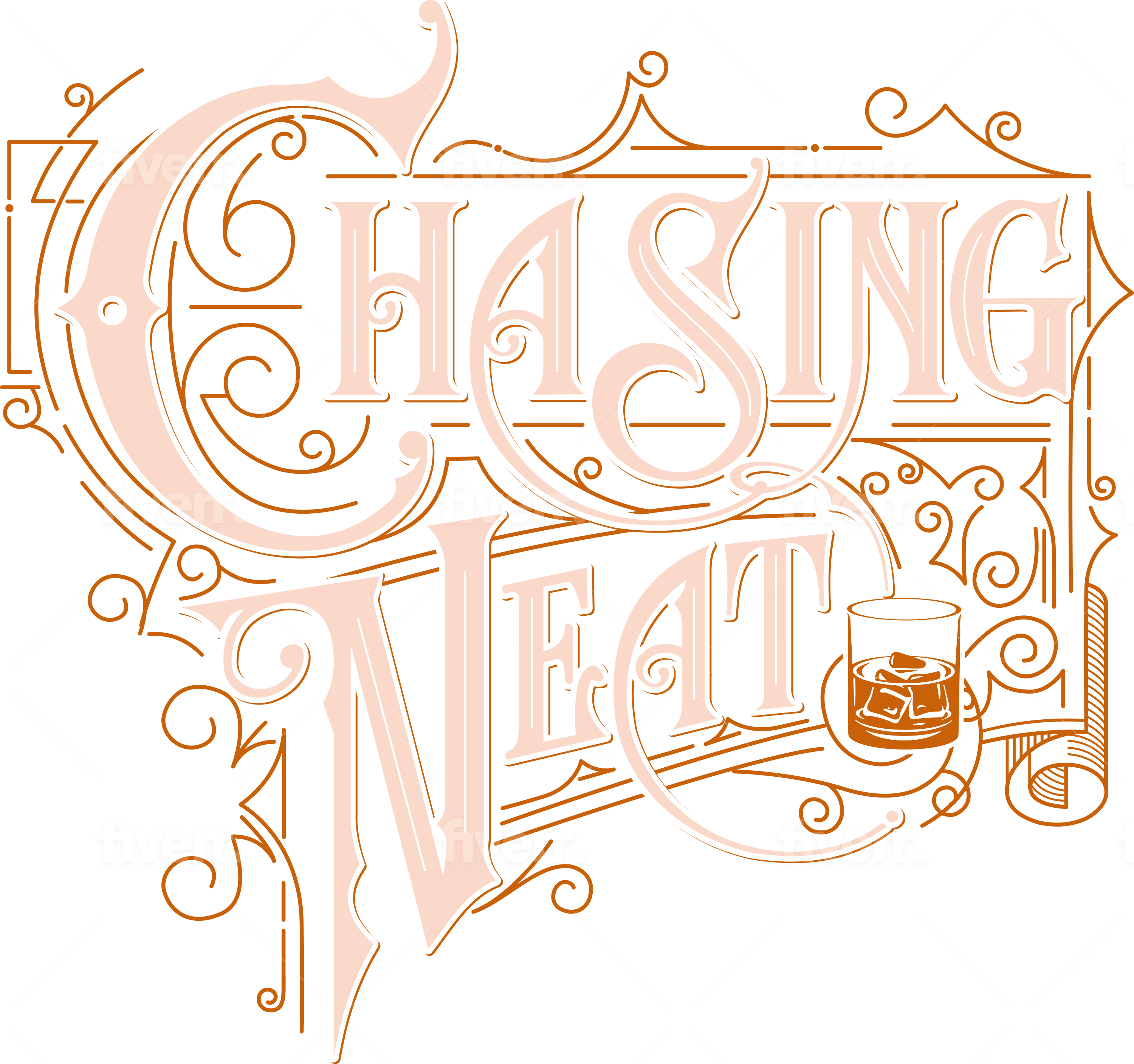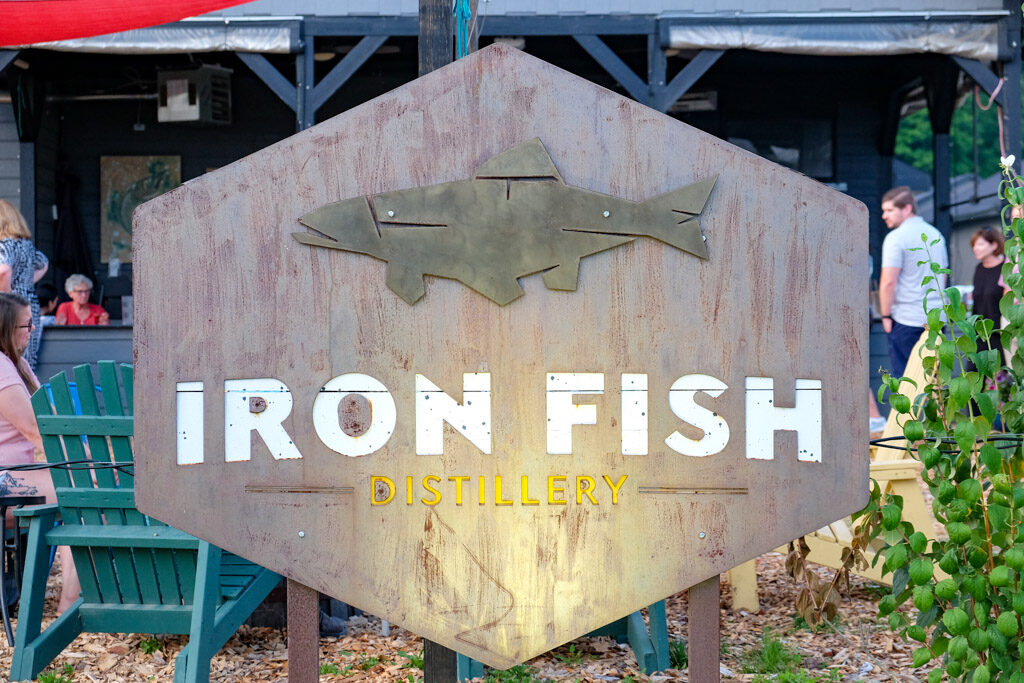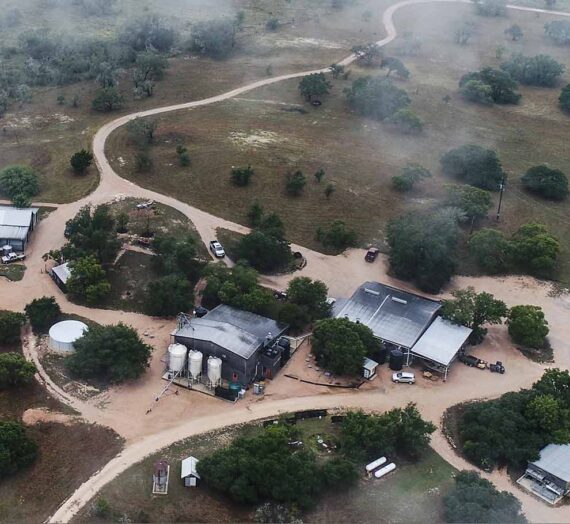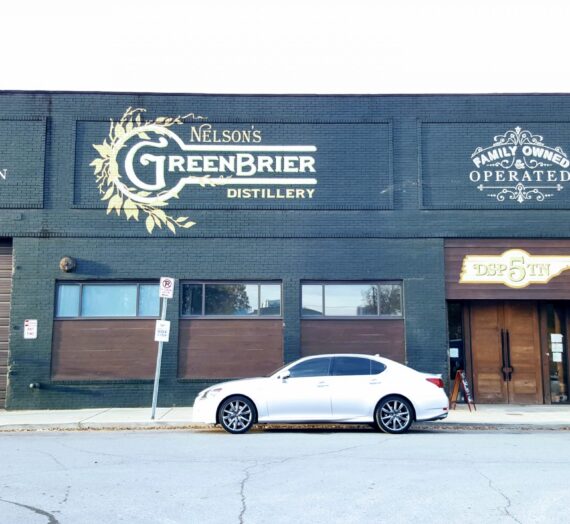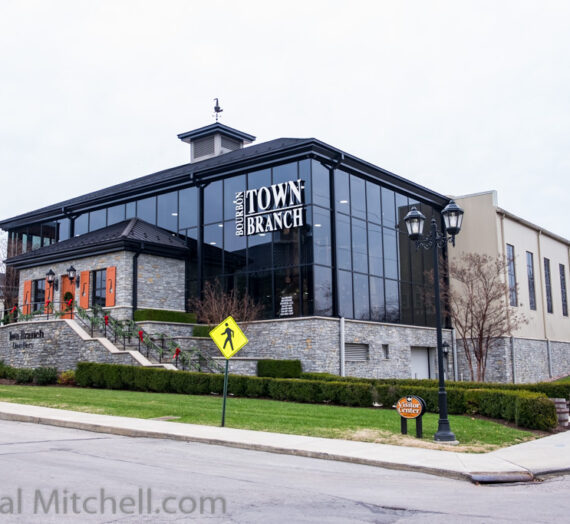At the end of a long and dusty, dirt road lies a wonderful distillery named after the fish that swims back up the nearby stream to mate and spawn. It is a journey worth making for both the fish and for the Bourbon Curious.
As we traveled down the unpaved road, with nothing but fields on either side, we finally got to a sharp turn, and as we made the turn we quickly saw a group of buildings on the right, ahead was our destination: the Iron Fish Distillery, Michigan’s first farm distillery.
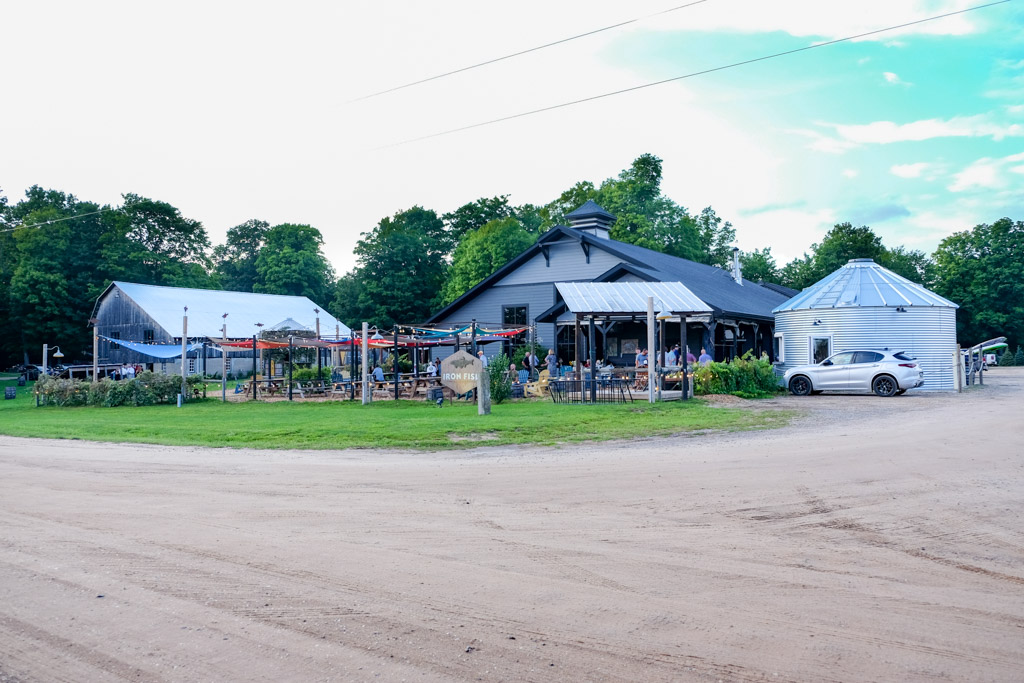
The Distillery was named after the Steelhead trout that starts its life in the nearby Betsie River but eventually travels to Lake Michigan to live out most of its life, only to return to the same river that it was spawned in so that it can repeat the cycle of life.
Dawn had arranged a tour of the distillery and a meeting with the owner in hopes that we could gather information for this story and to take video to make a feature story on our YouTube channel. Dawn was given a date and time and she made travel arrangements for four as we would be touring the facility with our good friends and fellow bourbon aficionados Dave and Nina.
Iron Fish Distillery was founded in 2016, as Michigan’s first farm distillery growing grain and distilling spirits, and barrel finishing sourced whiskey. It is a 120 acre MAEAP certified working farm.

The distillery is located in Thompsonville in northern Michigan, up by Traverse Bay. We left the day before and traveled the four hours it took us and stayed the night at our hotel in Cadillac, MI. It was a nice drive and reminded us of traveling South in Indiana, however instead of seeing endless cornfields we drove through endless trees it seemed.
It was a drizzly day with scattered bright sun and spotty clouds that sprinkled off and on throughout the day, a typical mixed weather day for northern Michigan. After driving down a dirt road, for what seemed like an hour at our rate of speed, but was really only a trip of 2 miles, we turned the corner and finally saw the farmland and group of buildings that make up the Iron Fish distillery. As we turned into the parking lot we could see, ahead of us, a sign for “Event Parking” and well dress people crossing the road. We would find out later that they were having a wedding at their event center/converted barn.
We got out of the car and walked a short distance across the gravel stone parking lot to the hostess stand outside the restaurant and bar. We were promptly greeted, and after we told them who we were they informed us that they were expecting us and quickly asked us if we would like cocktail while we waited. Of course we said yes, and they handed us a drink menu. Dawn and I both ordered the Salted Maple Old Fashion, while Dave and Nina each had their 1887 Old Fashion. Each version was well made and very tasty.
With drinks in hand we walked a few steps to the gift shop which was housed in a newly made twenty foot tall grain silo, ironically made in our neck of the woods by Chore Time Brock. It was impressive to look at from the inside with wooden beams arranged in a radial pattern with a ceiling fan at the middle. Three quarters around were all shelves filled with Iron Fish spirits and merchandise, the remaining section housed the cash register and sampling counter. We would return their after the tour and acquire our selection of spirits and gifts to take back with us, we never leave empty handed!
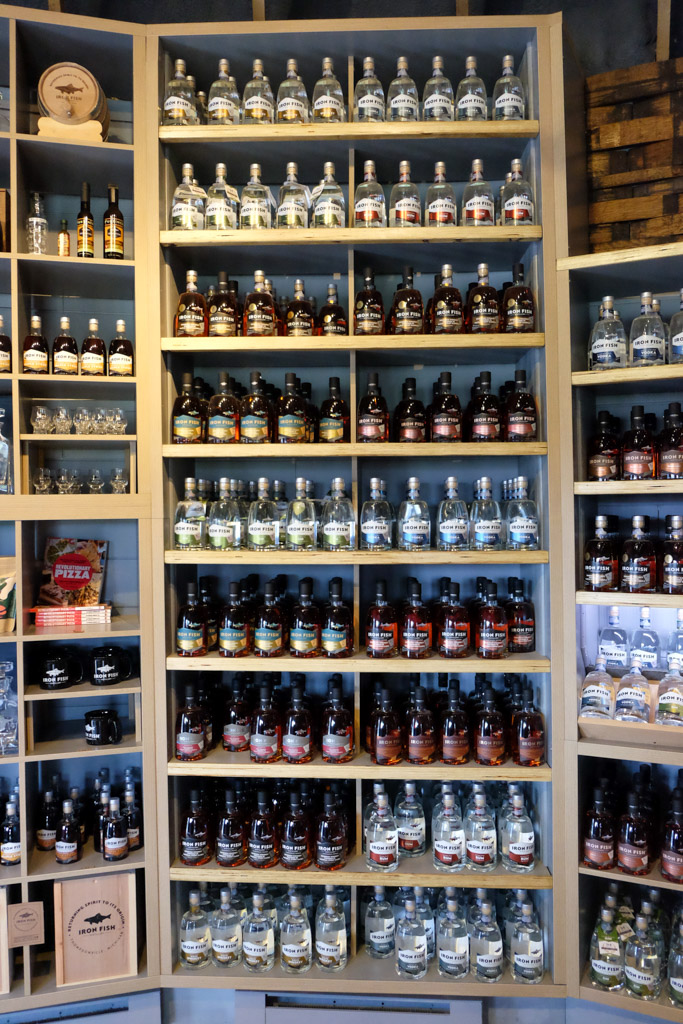
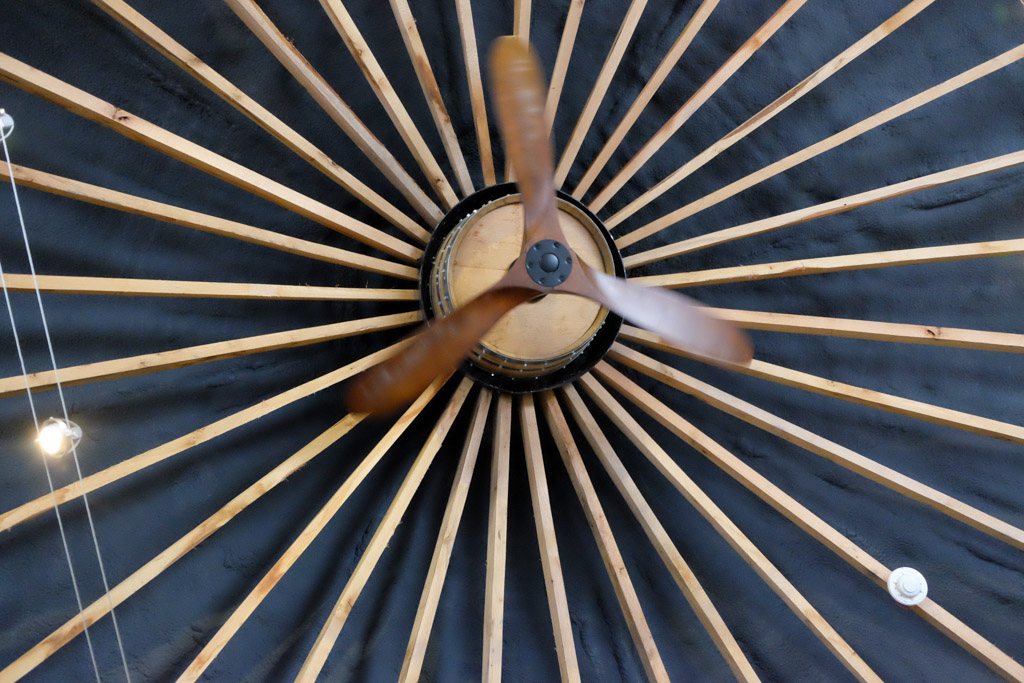
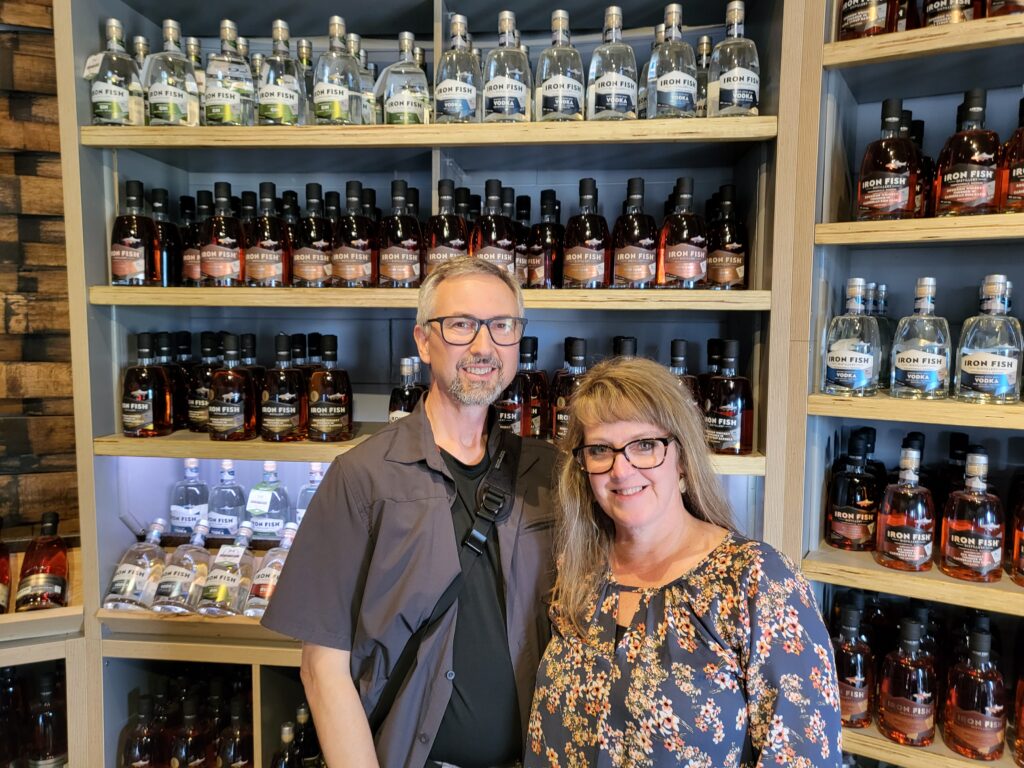
Our tour guide for the day was none other than one of the owners of the distillery; David Wallace. David greeted us in the gift shop and we followed him outside where it had stopped drizzling. We gathered in the front yard with the main building behind us and David preceded to tell us the history of how Iron Fish came to be.
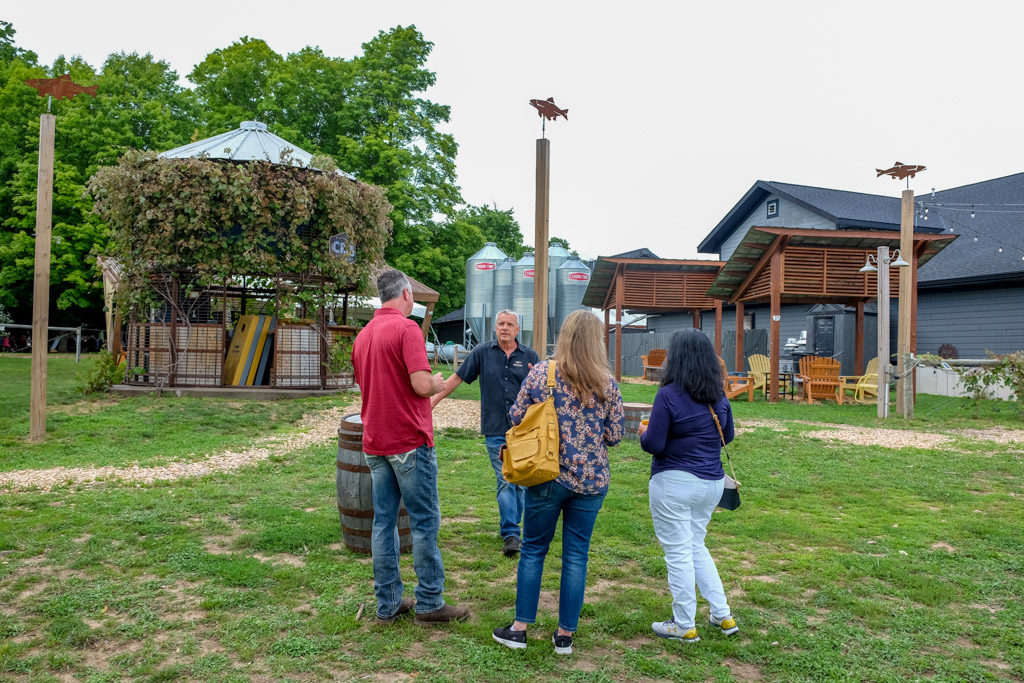
The 360 acre farm was originally owned by George and Iva Chamberlin who purchased it in 1887 paying $500 for it according to the records still kept in the house. George and Iva worked the farm until 1940 then his son Victor and his wife Martha took it over, farming it until the early 1990’s. Interestingly the house only got an indoor bathroom in 1988. Victor and Martha left the farm when they were in their 90’s and moved to Frankfort and the house and farm sat vacant until David and his wife Heidi purchased it in 2010.
What lead up to the purchasing of the actual farm that was to be turned into Iron Fish Distillery, was wanting to be able to vacation close to home. Both Heidi and David were born in Saginaw, MI but Heidi’s mother was born and raised just 15 minutes from the farm and they would often return their to vacation. When a property located on the nearby Betsie River became available they purchased it in 2000 as just a place to stay when they wanted to go someplace to hike and fish.
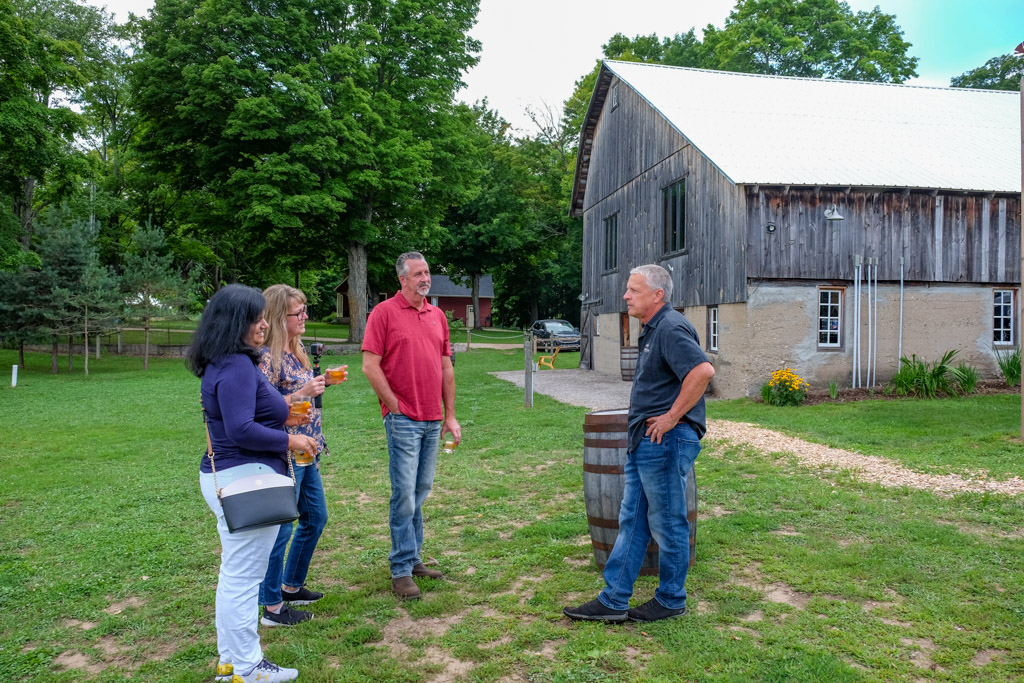
Around 2010 a For Sale sign went up on the field across from the farm and they bought the 44 acre plot thinking they might play around with it to grow hops and grapes. Soon after, in 2011, the 77 acres farm across the road became available and they bought it, in part so David could use the barn to store his tractors and so that Heidi could turn the farm house into a Bed and Breakfast. After renovating the farm house, Heidi turned the barn into an event center and David lost his place to store his tractors.
In 2013 because both David and his brother-in-law–Richard–liked peaty Scotches. Richard’s wife Sara got her husband a trip to Scotland to go to the island of Islay and since Sarah didn’t want to go, David went with him along with another sister’s husband so all three brother-in-laws went together. The three brother-in-laws spent four days visiting nine different distilleries. During one of the tours one of the brother-in-laws jokingly said to the others: “we should start a distillery in Michigan.” To this day none of them admits to saying it, although they all say that it was, indeed, said.
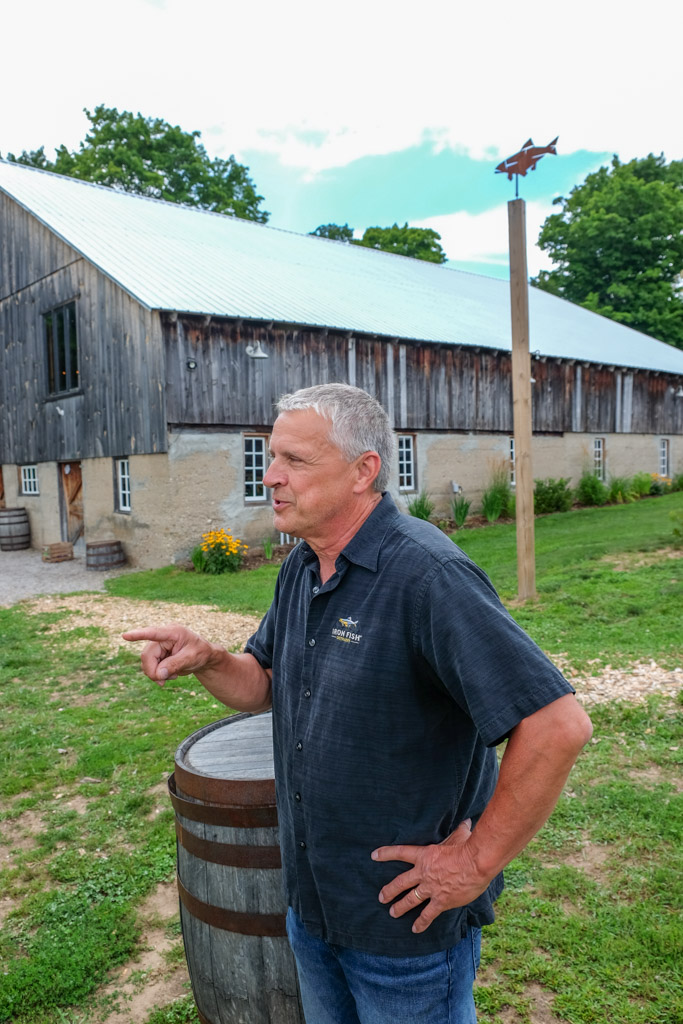
Soon after returning from their the trip to Scotland, David couldn’t quite let the idea of starting a distillery go, so he found a distillery in Chicago named Koval that was offering classes on distilling. Koval also just so happens to be a representative for a still maker out of Germany named Kothe Destillationstechnik.
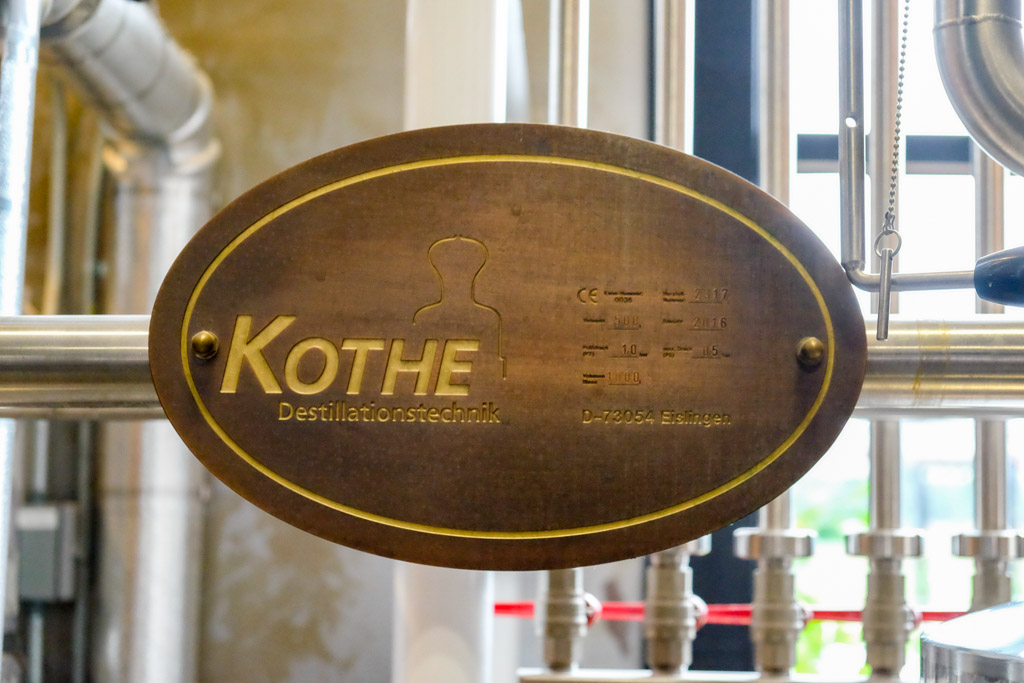
After thinking about it for a short while, David called up Koval and put down a large deposit on a still then called Richard and half jokingly told him that Richard had just purchased “himself” a still. Since it would take 18 months to get both the still in from Germany as well as the needed permits and licenses, they took the time to find a suitable location for their upcoming distillery. After a short list of possible towns in Michigan was made it was finalized that they would just build the distillery on the farm.
In late September of 2015 over 50 community leaders and neighbors found their way down the dirt Dzuibanek Road on a brisk Monday morning for the ground breaking ceremony and also a big reveal of the building design and farm-based distillery plans.
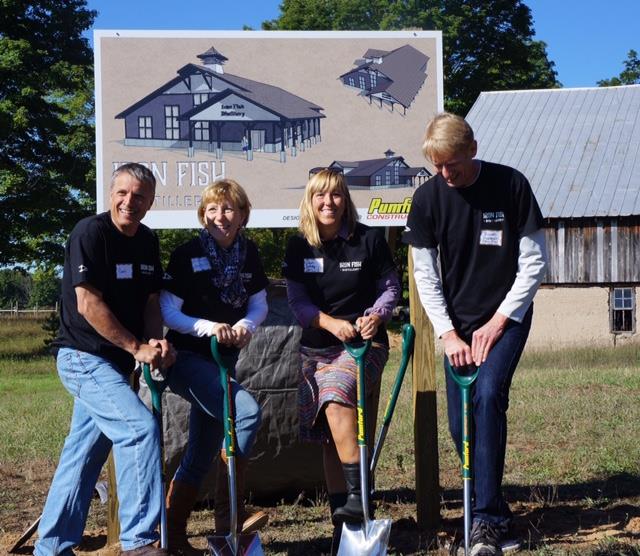
From L to R: David Wallace his wife Heidi Bolger, Sarah & Richard Anderson
The acclaimed northern Michigan poet, Michael Delp, kicked off the event with a reading on the spirit of the Steelhead trout that run the nearby Betsie River.
Steelhead Dreams
by Michael Delp
Tonight, just before I fall asleep, I hear the wind kick
up in the red pines outside the house. I begin to go
under, begin to submerge myself in a dream I know is
waiting for me. “The steelhead run with the wind,” I
remember someone saying. And I think of thousands
of fish gathering at the mouths of rivers up and down
Lake Michigan. I begin to think of my bed and how I
lie on top of it as some way I am able to hover just over
the dream. As if the dream itself were made of water
and I could lower myself down into a river choked with
March ice. Holding. Just off a river mouth.
I listen. Underwater the wind sounds like thousands of
waterfalls. A dull roar. A roar coming from far off and
seeping gradually into my head. There are hundreds of
fish waiting. They fan slowly, move up and down, some
sideways in the current coming out of the river.
If I listen clearly enough to the inside of my head, I can
hear the sound of some old command, some old
memory let loose far upstream calling me in.
The water turns chemical. Chemicals loose in the tiny
brains of these fish washing through their bodies,
urging them up river.
They surge through deadfall, upstream, rounding bends
deep underwater, the sound of the river mixing with the
sound of wind. All chemical. Something drifting now in
their bodies. Bodies that look like pure aluminum
muscles loose in the water.
David and his brother-in-law Richard, never had definite plans on what and how much to produce, they just knew that they wanted to eventually make a four year old Rye and Bourbon whiskey. Their “Plan B”, if things didn’t go well, was to be able to sell the still to someone that did not want to wait the 18 months it took to get one made. They have not needed to use that “Plan B” yet.
After the building was built, they installed their still which is a custom-build pot still, handcrafted in Germany by Kothe Destillationstechnik. It is a pot still, specifically made for the production of whiskey and brandy, and their column still, for vodkas, gins, liqueurs and other clear spirits, has been designed to provide just the right amount of surface area for the spirits to develop aroma and flavor.

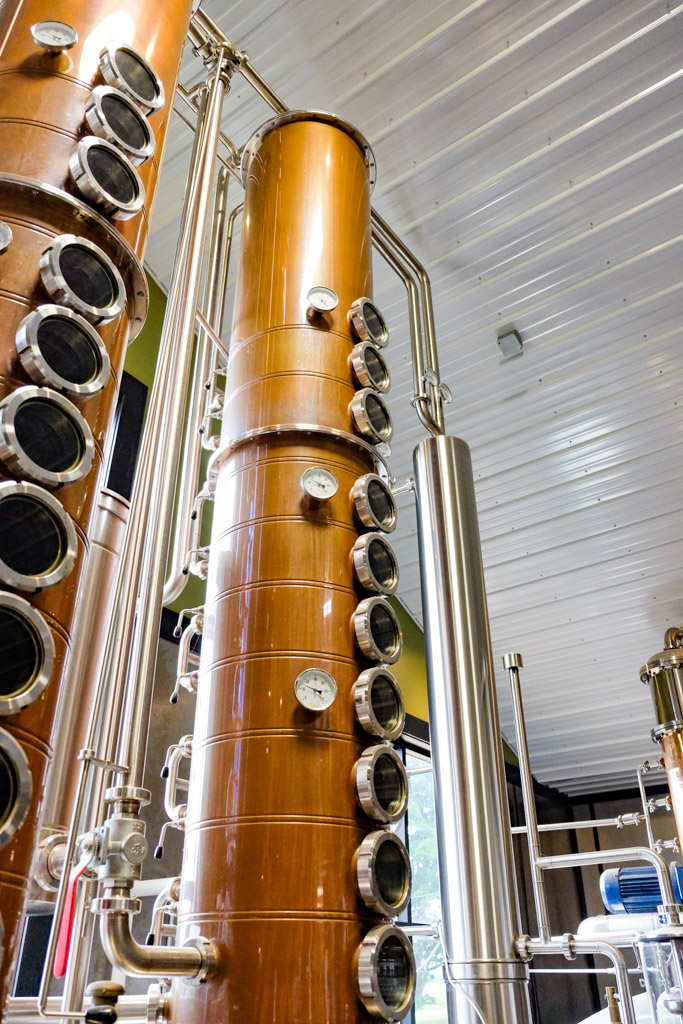
After firing up the still, they started making Rum and Vodka as that was the fastest spirit they could make and turnaround to sell. Shortly after they distilled their first Gin. Their Gin is rather special as it is the first Gin in the world to use Concolor Fir and they get it from the local Antioch Tree Farm, which harvests about 35,000 trees a year. The aroma is a citrus cross between an orange and a lemon, and does make for a very interesting and pleasant Gin. Not your typical London Dry Gin with its heavy overtones of Juniper.
As time went by, they hired a nearby distiller and they started making their first whiskey. Their first mash bill would be wheat, as that was what their distiller knew best, and they distilled soft white winter wheat grown on the farmland across the street. Their four year wheat whiskey will be released later this month and they will release their 4.5 year Rye and 4.5 bourbon right after that. The “iron fish” have returned home.
In the interim while their own bourbon aged, they started “finishing” bourbon from MGP. Iron Fish has two product categories or series: Finish and Estate. The Estate Series are products made from their own distillation. The Finish Series are products that they purchase from others and then put into hand selected secondary barrels that previously held such things as maple syrup, Mezcal, and beer.
Much to their credit, Iron Fish sources these barrels from local producers. The maple syrup barrels come from a five-generation family business that produces the finest Maple Syrup in the state, the Griner Family Sugar Bush. They have been making maple syrup since 1890.
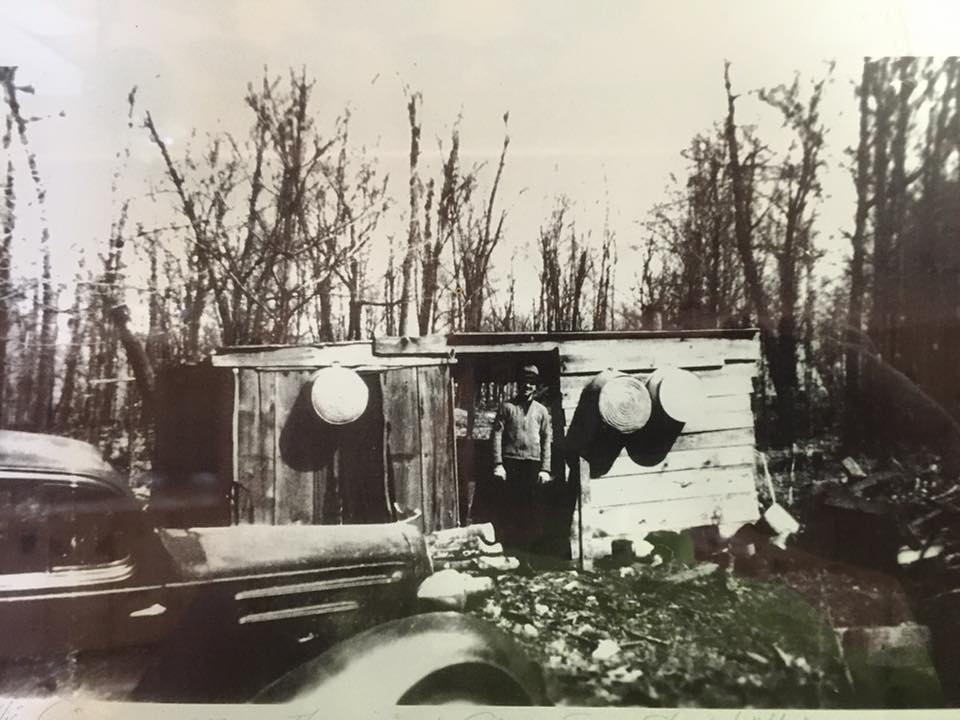
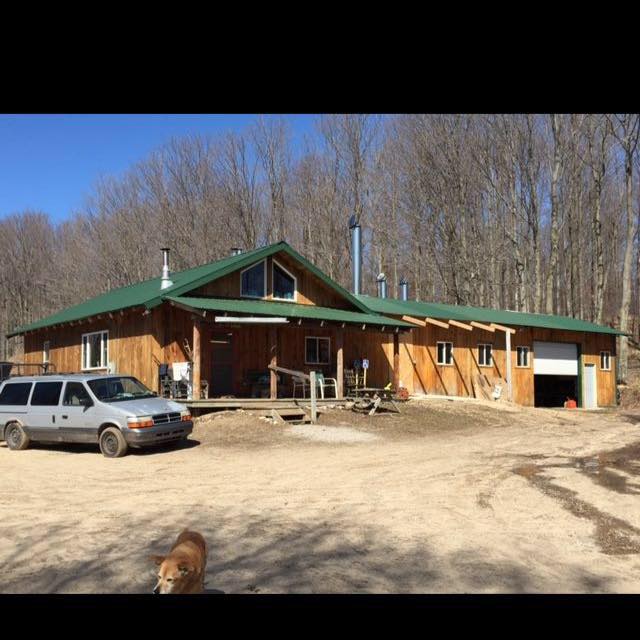
David finished his history lesson of the making of Iron Fish Distillery and he then started to lead us on a walking tour of the buildings and grounds. At one point in our walk, we heard a thunderous cheer and applause. We quickly surmised that the “I now pronounce you husband and wife” had just concluded at the near by wedding ceremony.
We walked on and past the silos holding their grains, and into the milling area located adjacent to the stills. From the milling area we went directly into where the stills and fermenters were located, where David began to tell us about their stills. The first pot still is up for sale and their current 250 gal still will be supplemented with a new 1,000 gal still. Currently they can do about 250 barrels a year running their one shift. Once their new still is in place they should be able to do 600 to 700 barrels a year running on a shift and a half.
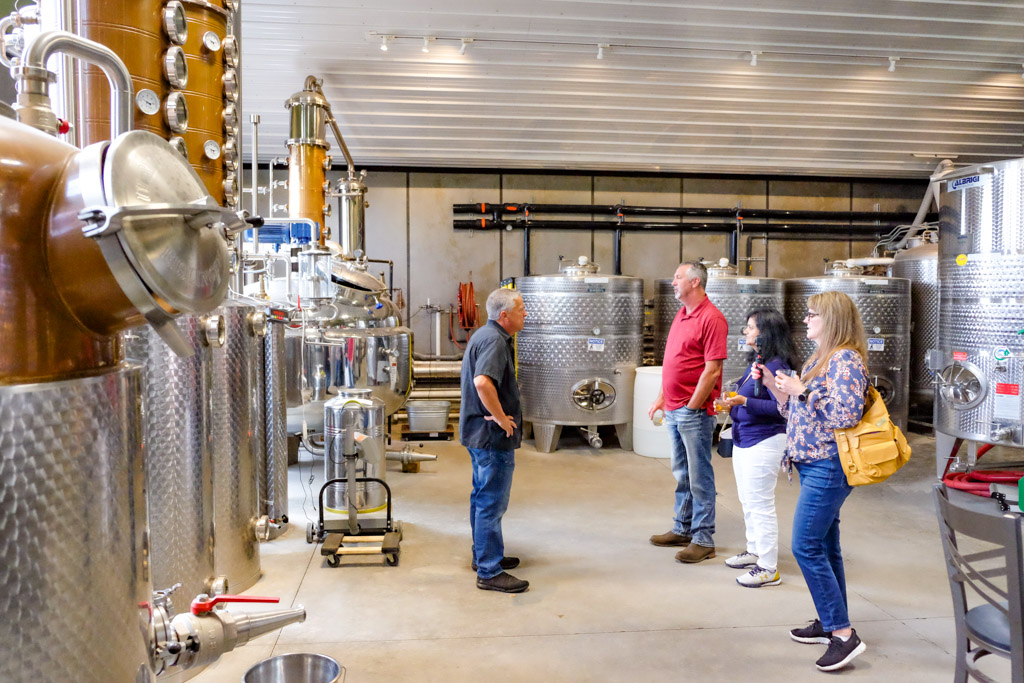
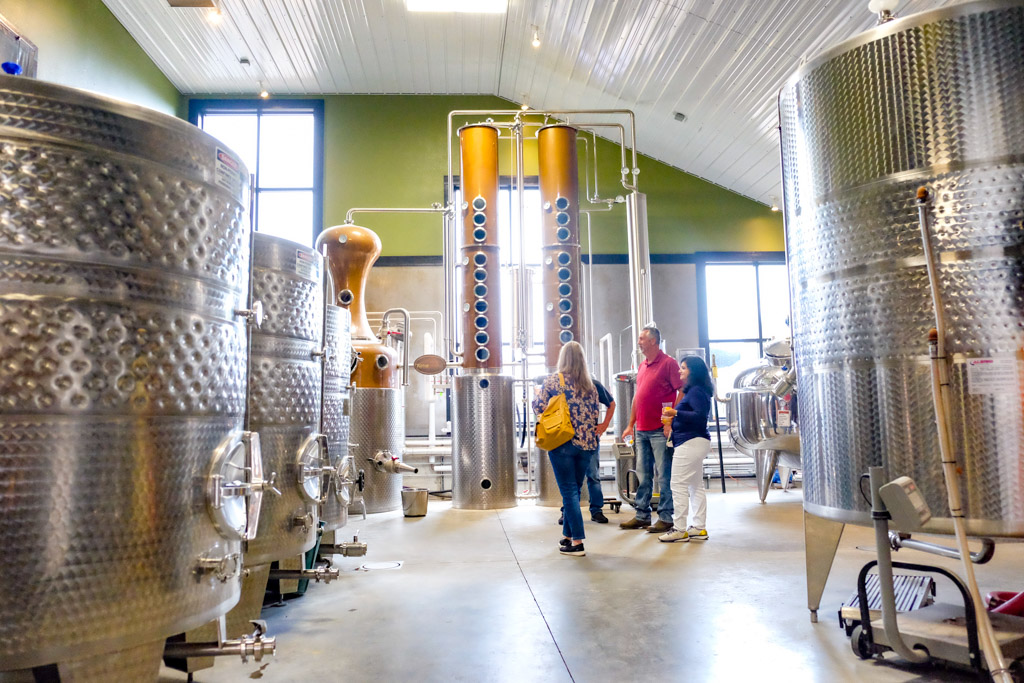
Their current fermenters are 500 gallons and that is their typical batch size. When the new 1,000 gallon still arrives they will go with 2,000 gallon fermenters. Along with those new pieces of equipment will come a location change for the still house. With those additions they will have exceeded the room available in their current stillhouse and will move the stills and the fermenters to a larger building next door. The upstairs portion of the current stillhouse will become a speakeasy, which I am sure will get a great deal of use.
From the stillhouse we walked to the original rickhouse building which will soon become the new stillhosue. This is also where David conducted his tasting session. This rickhouse stores barrels five barrels high and five deep by eight long for a total storage of 200 barrels. This building also is where the bottling line is. They weren’t running the line at the time but they did have the Copper Queen labels ready to go.

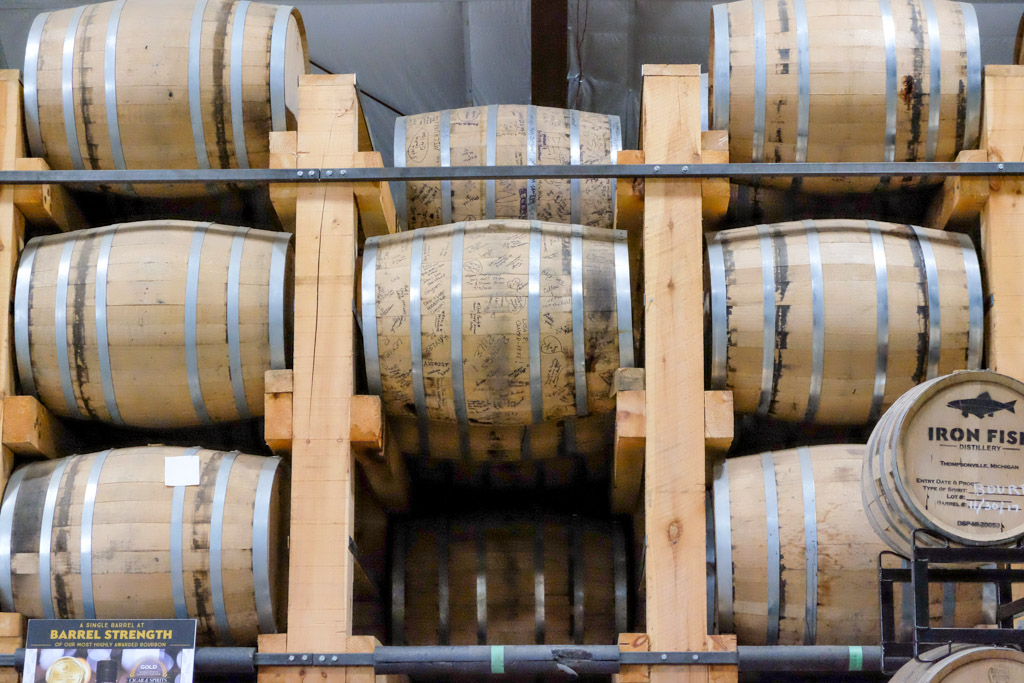
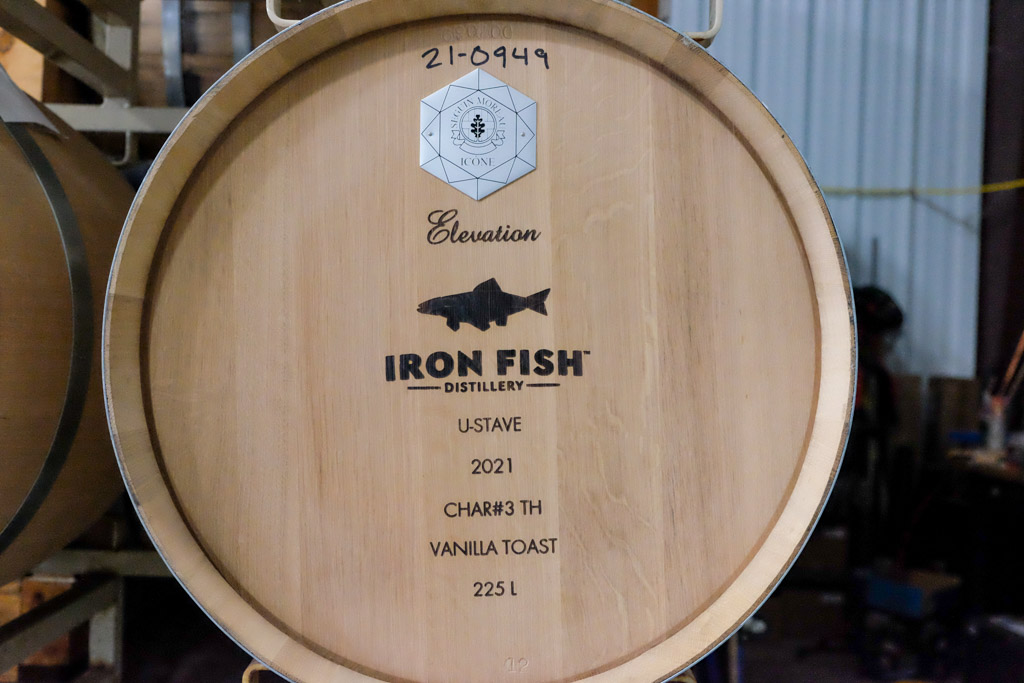
Since their opening David told us that they have had three different head distillers, with their third and current head distiller working with an assistant distiller. However the mash bills, blending and finished products are David’s responsibility.
From the first rickhouse we then moved to the rickhouse containing the maple syrup barrels, boy did that building smell good! This was building number four, however the buildings have no numbers actually on them, instead they have a number of fish icons on them representing the actual number, so this rickhouse had four fishes on the side.
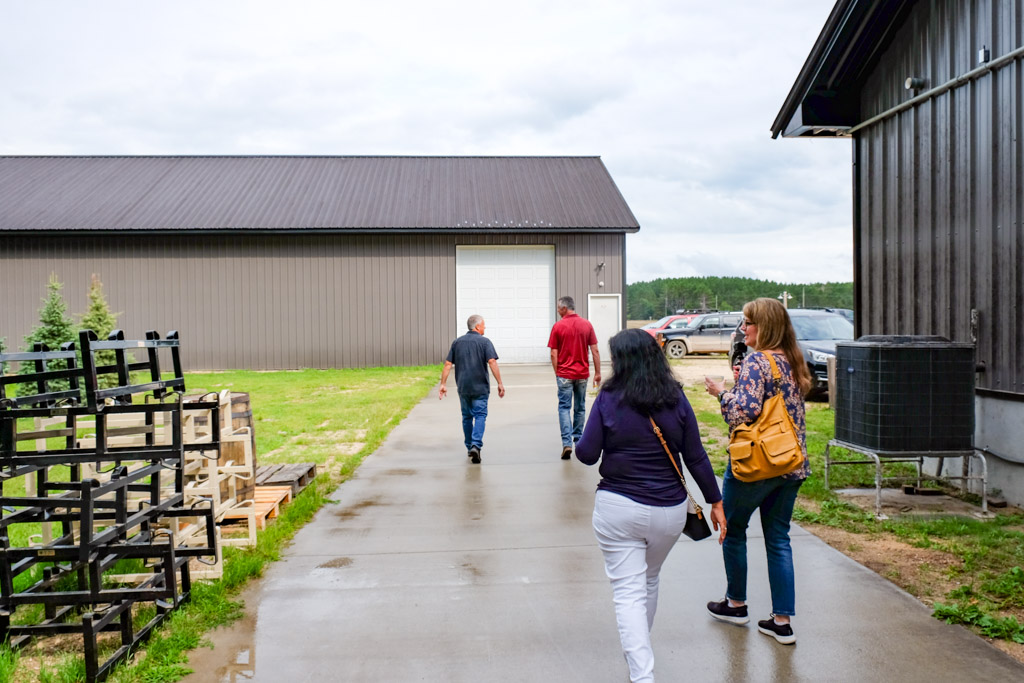
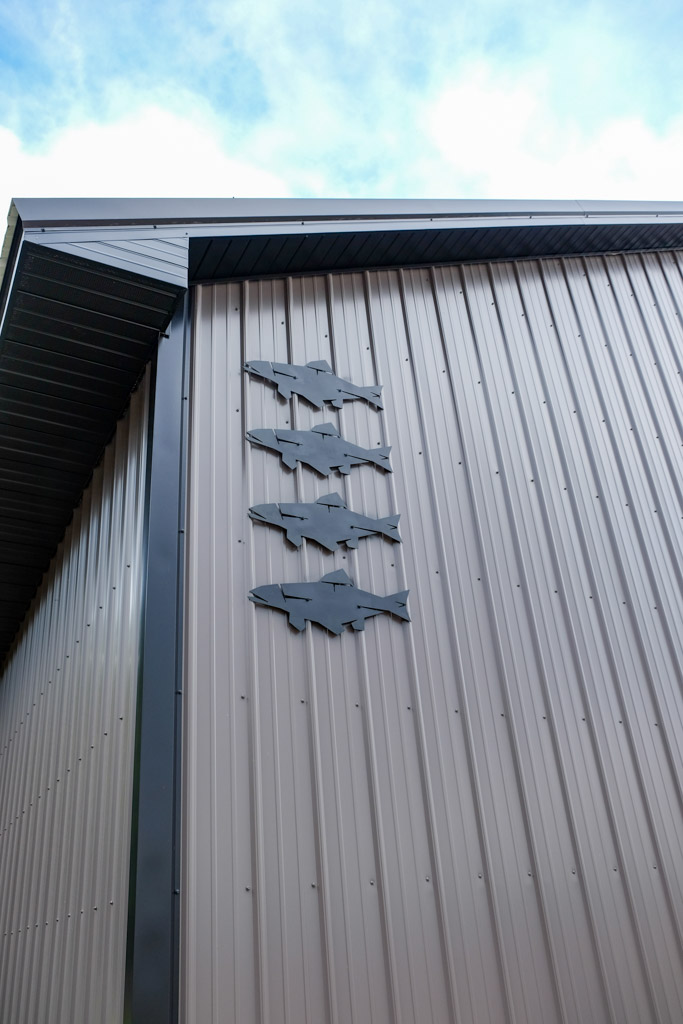
Not only did this rickhouse attracted us, it attracted the bees. They have to make sure they keep the doors closed and when they open them they are quick to go in and out as the bees will jump at the opportunity to get in.
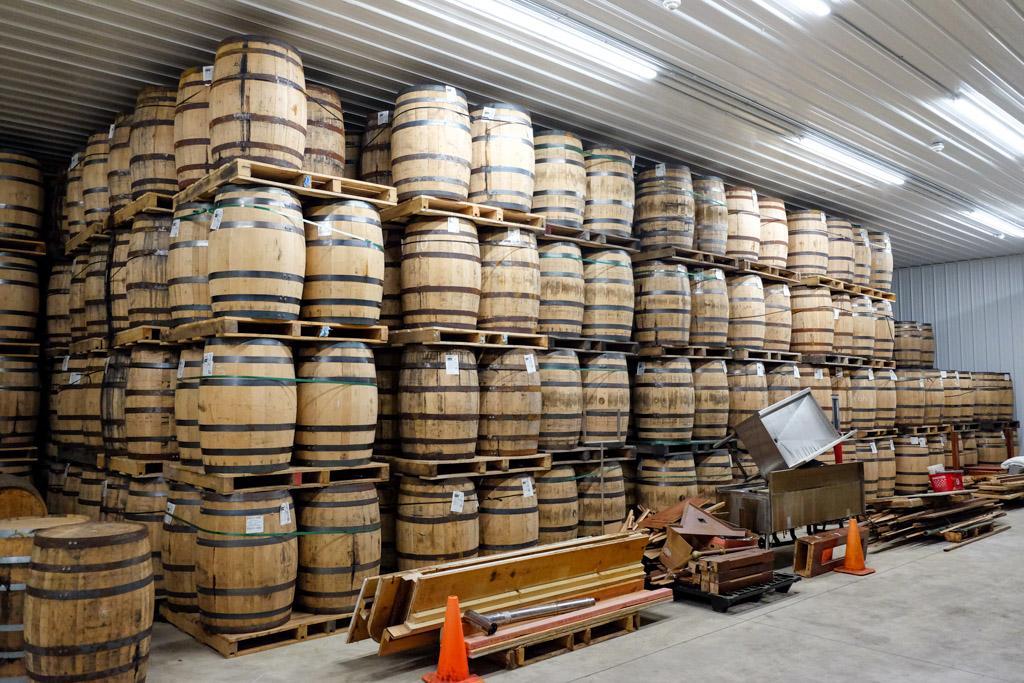
David explained the progression of the maple syrup barrels. They start with a fresh bourbon barrel that they then fill with local maple syrup and let that mature for about three to four months. Then they bottle the syrup and then put purchased bourbon into that barrel which eventually becomes their maple syrup bourbon. After they have bottled the maple syrup bourbon, and are finished with the barrels they sell them to a local beer maker who then age their beer in them. The cycle of life for the barrel, the Iron Fish has come home again.
We all walked back into rickhouse with the two fishes on it and David began the actual tasting. We started with their wheat vodka, which is distilled at 190 and un filtered. They also make a rye vodka. It was good and non-traditional as it is not a neutral spirit as it has a good taste of wheat to it. For basically “hand cleaner,” we all found it good. (Inside joke.)
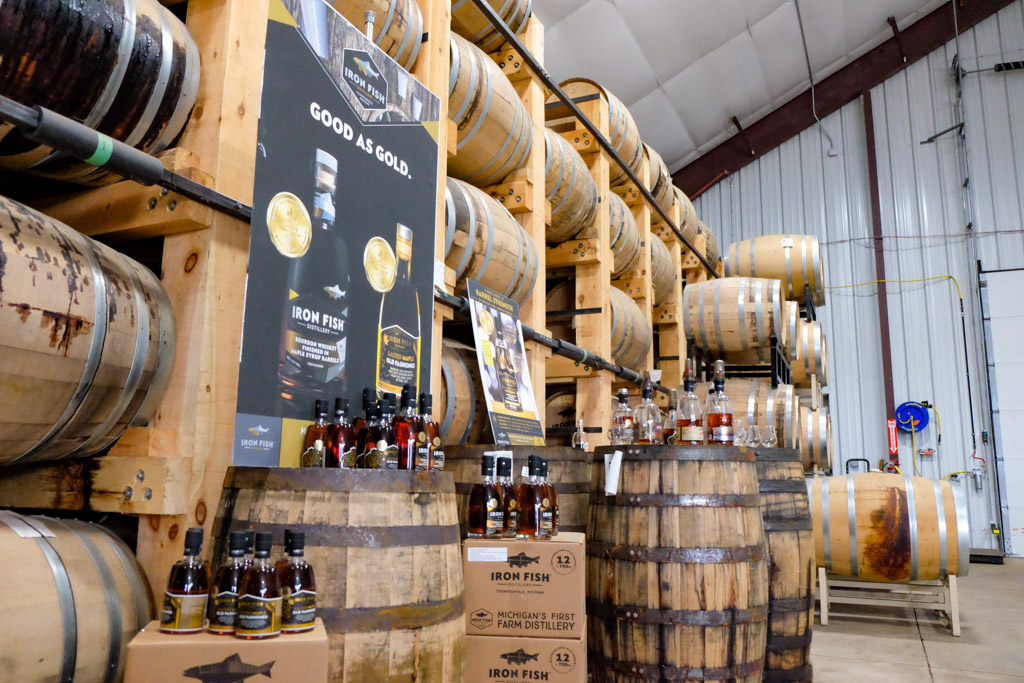
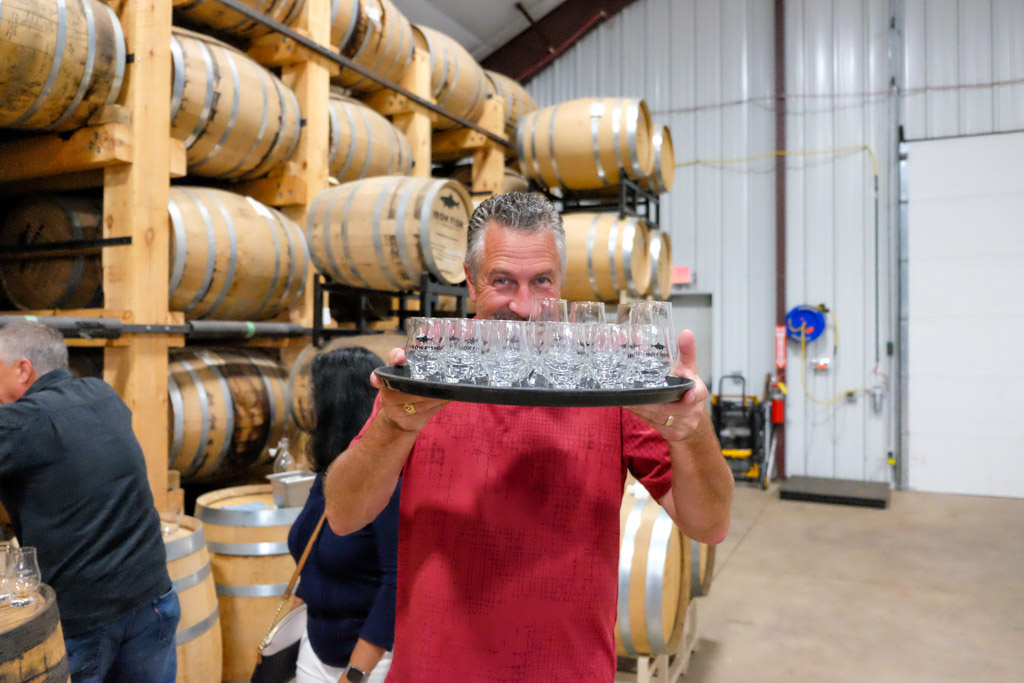
The next spirit David had us try was their Gin. It is made rather uniquely in that it is the only gin in the world to use Concolor Fir and they get it from a local tree Farm. The nose and pallet is a pleasant citrus cross between an orange and a lemon. The mid pallet was pine with a hint of orange and a finish of faint licorice.
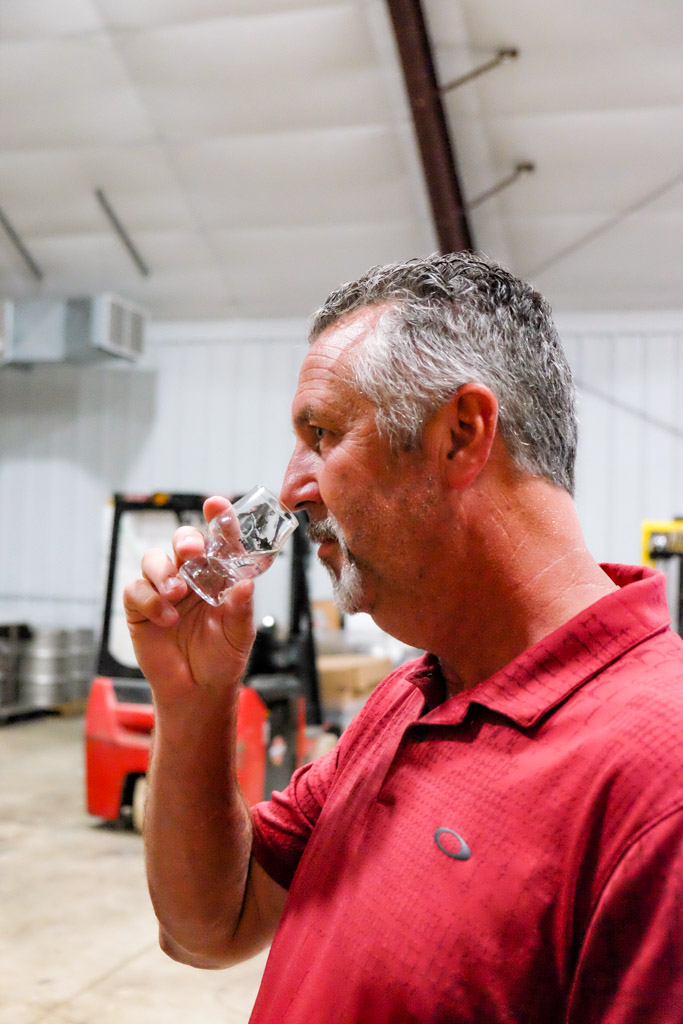
They created this Gin using a little 5 gallon still and experimenting with mix of over 20 botanicals, none of which David liked so he switched gears slightly and made Gin out of each botanical individually. Once all 20 were made he gathered his testing team together and they started blending with those individual components. During one of the blending sessions a tall 6 foot 5 inch man with a dark, black beard walked into the tasting room and with a deep voice said: “Dave, you need to use this to make your Gin!” and handed him a tree branch.
David did use that branch, actually the needles from the branch in a batch of Gin and everyone like it so much that is what they use today to make it. It turns out that the tall, bearded, branch caring man owned the local tree farm and whenever he walked through a certain section of his farm, the citrus smell was so strong that he new it would make a good Gin. Now the arrangement that David made with Blake was that he can use as much tree clippings as they need and David gets Gin for life. When you go to their bar, try their Wile E. Coyote.
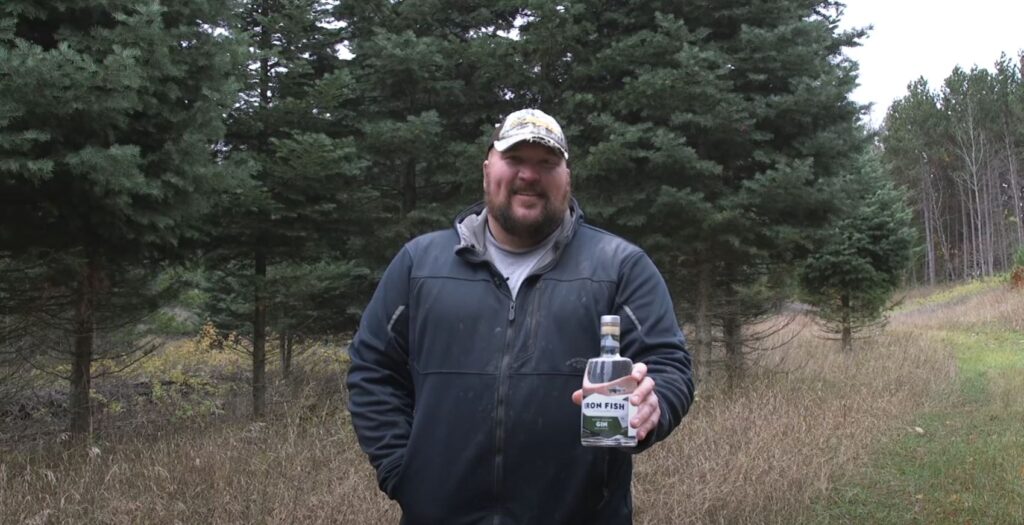
Next on the tasting list was the Maple Bourbon, which came in at 86 proof. The first impact was that it had more heat then the 86 proof would suggest. However that first impact of alcohol quickly subsides with no other residual sharp notes and nicely moves into sweet notes. We all agreed that this bourbon would make a perfect starter bourbon for someone who wanted to drink it neat. David told us that the bourbon finishes in the maple barrels from 6 to 12 months before being bottled.


Four Cask Bourbon Whiskey was up next. Coming in at 94 proof its a blend of four bourbon whiskeys each finished in rum, cognac, sherry and maple syrup barrels then blended together and put back into a barrel to create a unique pallet experience. This is David’s personnel favorite of their blended bourbons. I can see why, it has several unique notes on both the palate and finish. Part of the Bourbon Experience is discovering your own notes in a bourbon. This was Dave’s favorite as well (of Dave & Nina fame). The barrels used for this blend are sourced from Barbados for the Rum, Spain for the PX Sherry and France for the Cognac.

The one Estate Series whiskey we tried next was Mad Angler, which is a four grain whiskey with a mash bill of 51% wheat, 26% corn, 14% malt and 9% rye and came in at 90 Proof. They also make a bourbon and a rye version but we couldn’t try the bourbon as all the available barrels had just been dumped in preparation to be bottled. We all agreed that we wanted to try that version as well as we all liked the wheat version so much. It has a very good nose, palate and finish. It’s name is borrowed from Michael Delp a local poet that writes about the local watershed and who is “mad” about how people treat the local river and streams. There might be a “Mad Farmer” whiskey some day as there is a local farmer who is also “mad” so possibly look forward to seeing label that some day.
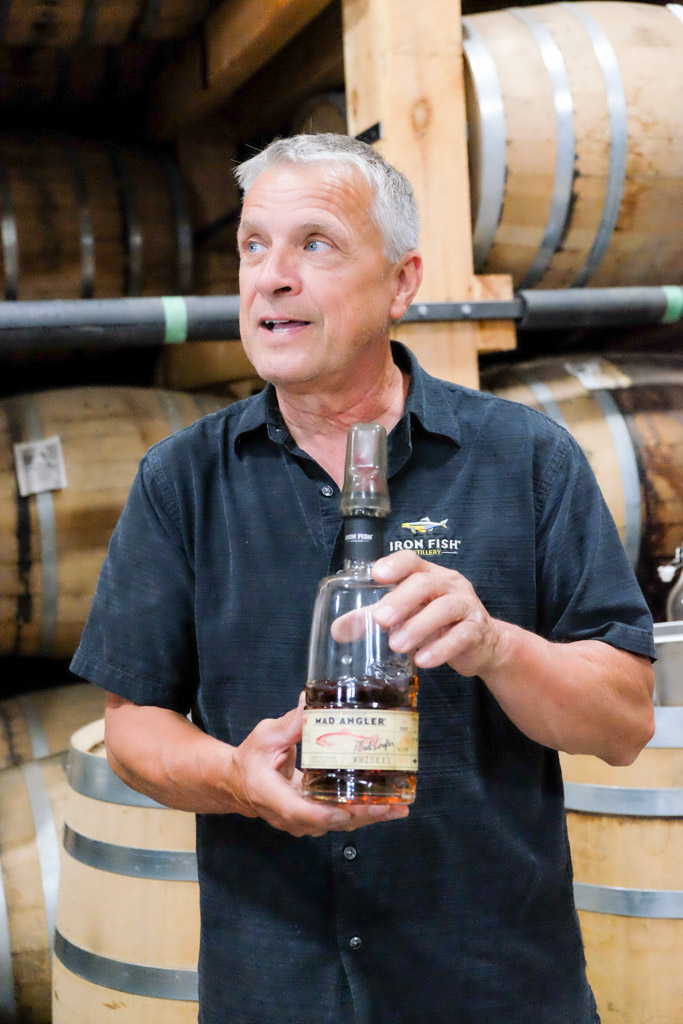
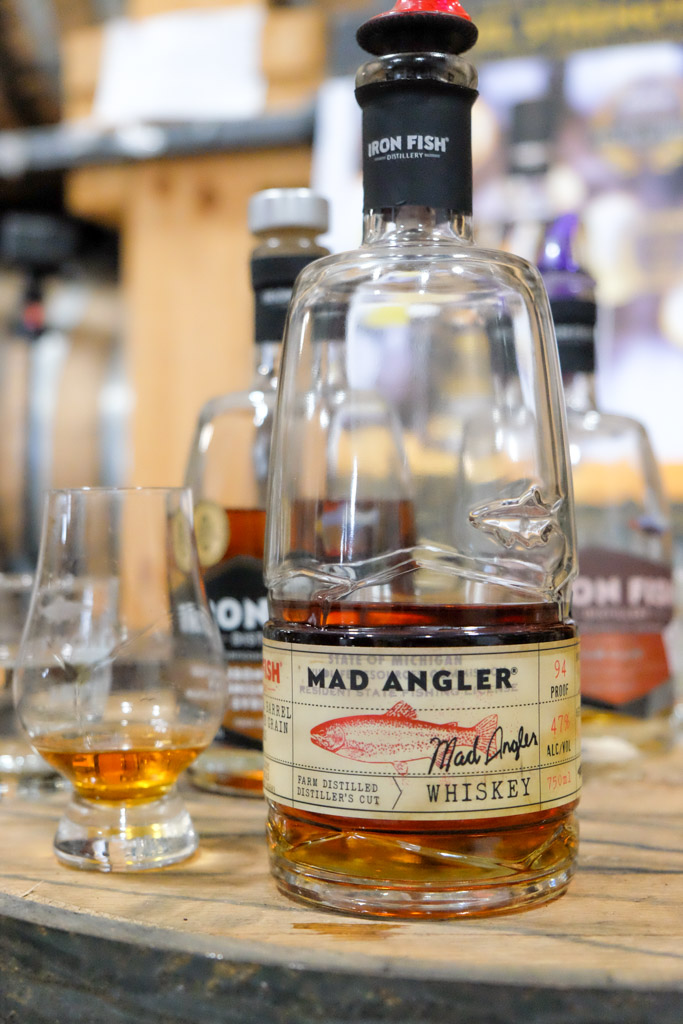
After tasting the Mad Anthony we got a chance to meet David’s wife Heidi as she was walking through the tasting room. Even though she like their whiskeys, she admitted that she is a “Gin girl” and really in love with their own Gin. Heidi is a CPA and business consultant and I think she does a good job at keeping “the boys” in line. “The boys” being her husband David and her brother-in-law Richard, who is responsible for the marketing and distribution end of the business and who is married to Heidi’s sister Sarah. Heidi’s title is: “Chief Reality Officer” according to David.
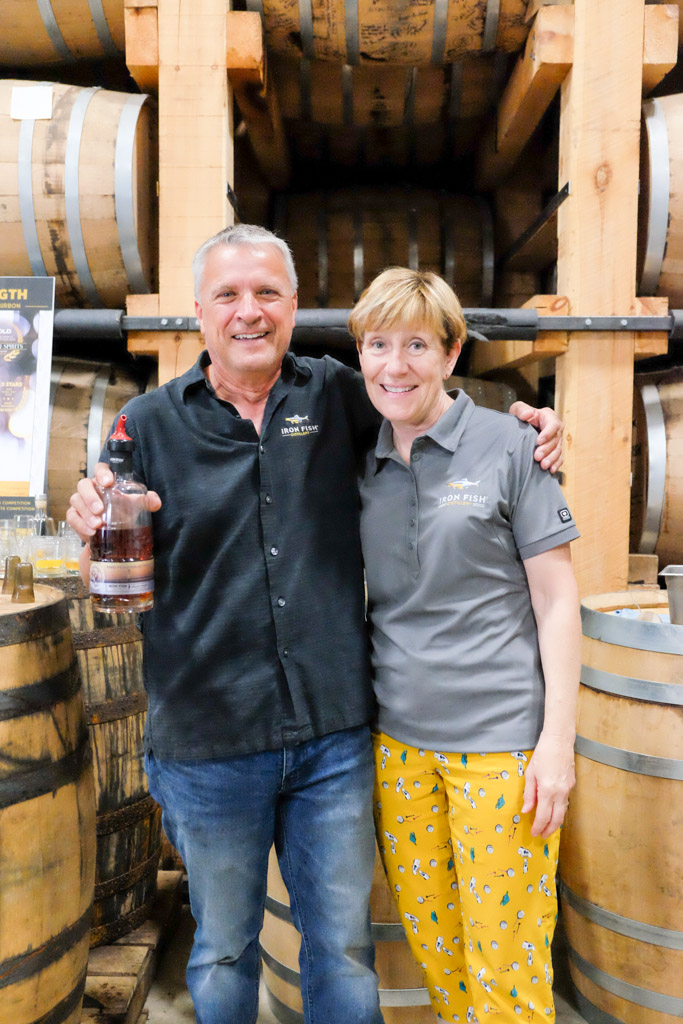
Next up was the Two Peninsula which is a high rye wheat whiskey. It has a dominant rye note on the nose. Dawn and Nina both got a “grass” note on the nose, and Dave found a “pepper” note. It really did have a strong rye influence on both the nose and palate to me, hitting me strongly on the sides of my tongue with a slight burn and sweetness combined. The Two Peninsula gets its name from the fact that the rye come form the northern end of Michigan while the wheat comes from the southern region.
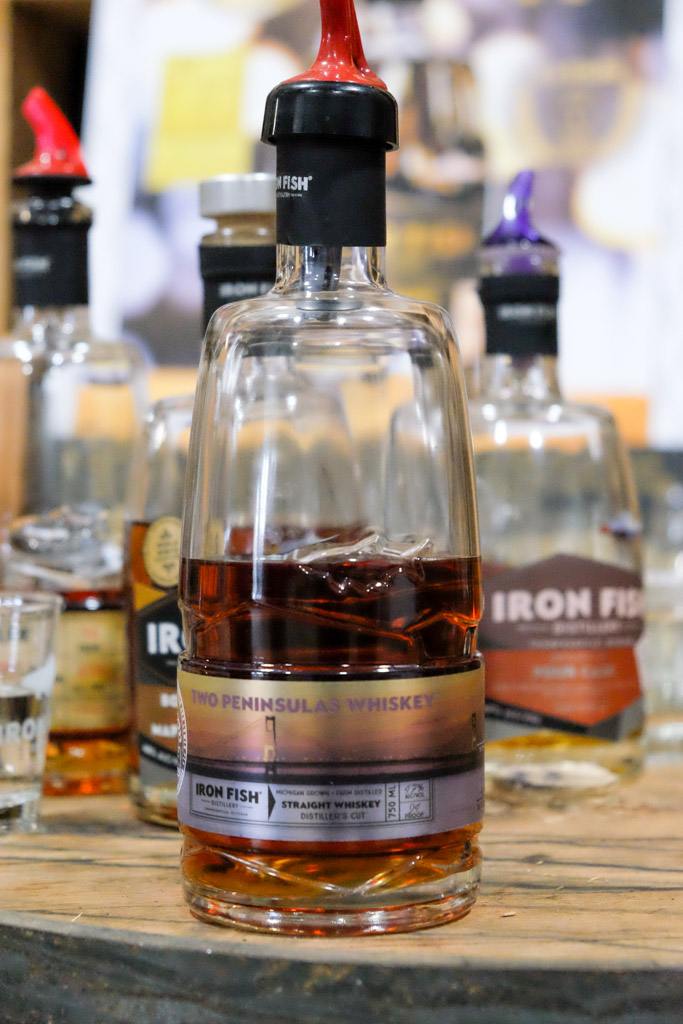
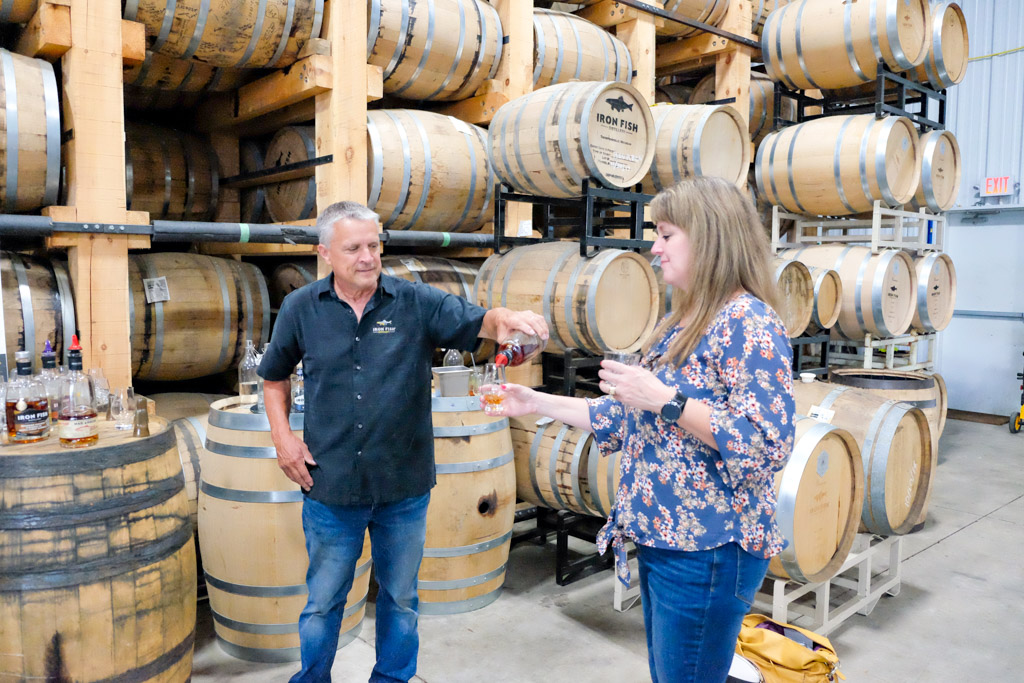
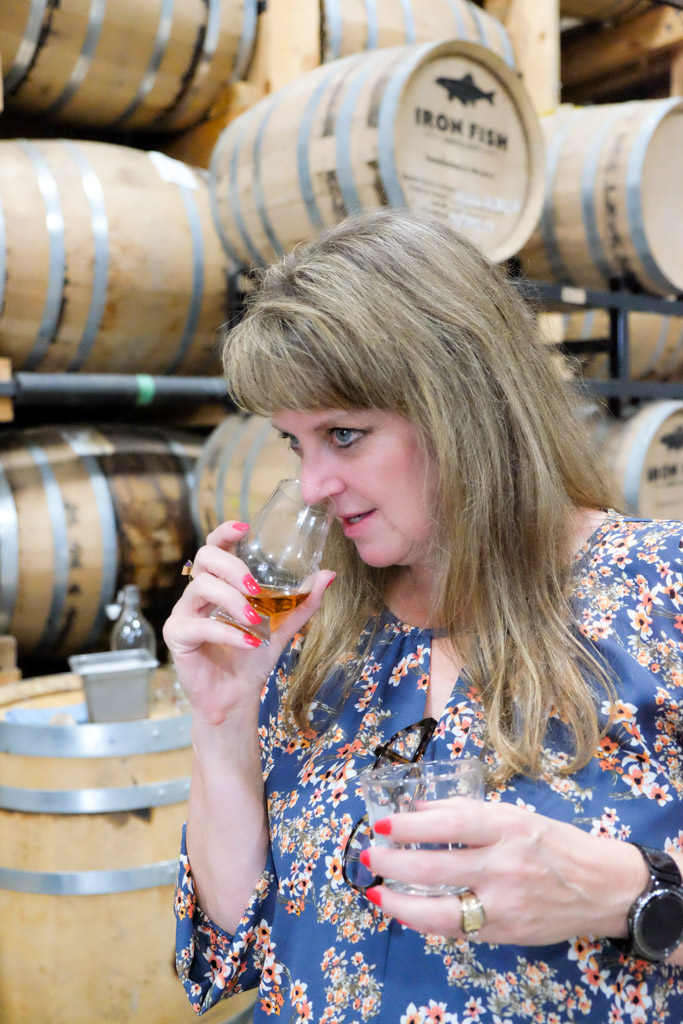
David is always experimenting with finishes however one of his experiments that wasn’t a barrel finish was with a new fermentation medium; tree sap. So as the experiment goes; they took the same sap that their partners make the maple syrup from and instead of boiling it down all the way to 66 Brix1 (66% sugar by volume) they only take it part way, just enough to begin the caramelizing process then they put it in their fermenters and let the yeast go to work on the sugars. After the fermentation process they distill it and put it into a used barrel.

This process give the resulting spirit (not sure what to actually term it) a very different nose that is quite pleasant. David let Nina pull a sample for us to take, and she was very happy to be involved in the process. Once in a Glencairn, I found the nose to be very reminiscent of their Gin, sweet and citrus, which was much diffident than how it smelled straight from the barrel to me. Dave got a little citrus when he nosed it but didn’t’ think it was like the Gin. On the palate, however, this was pure dessert. Dawn found the heat of it first, then the good sweetness. We proofed it down just a bit and that opened it up even more, bringing our the fruit notes even more. All four of us were ready to place our order for when they finally bottle it. Unfortunately, they only have the one experimental barrel, so it will probably be a while before it comes to market, but we sure hope it does!
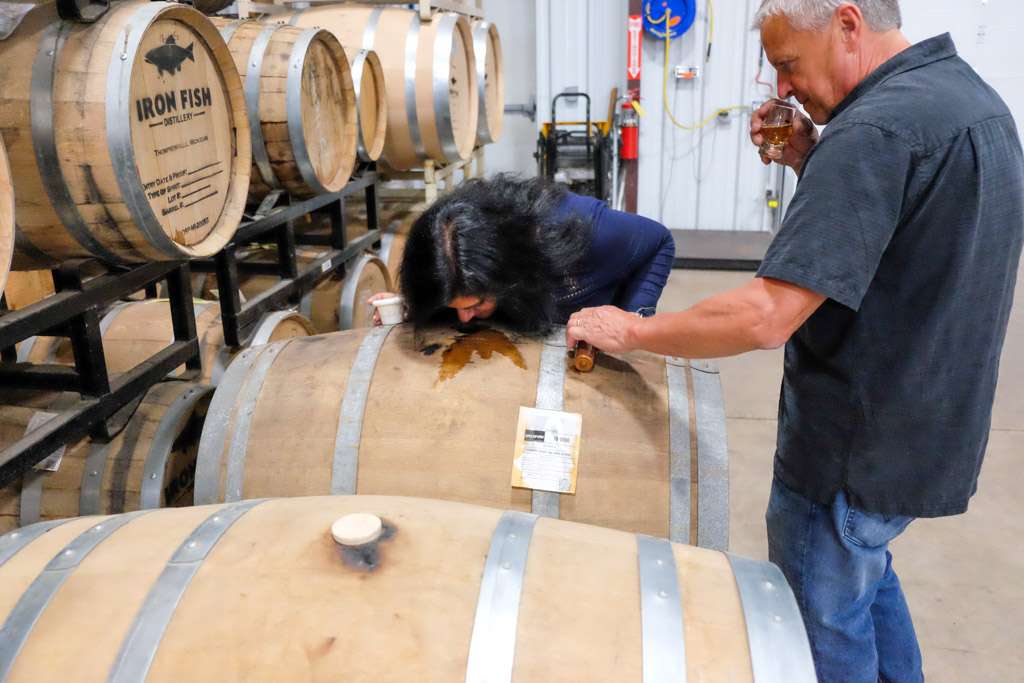
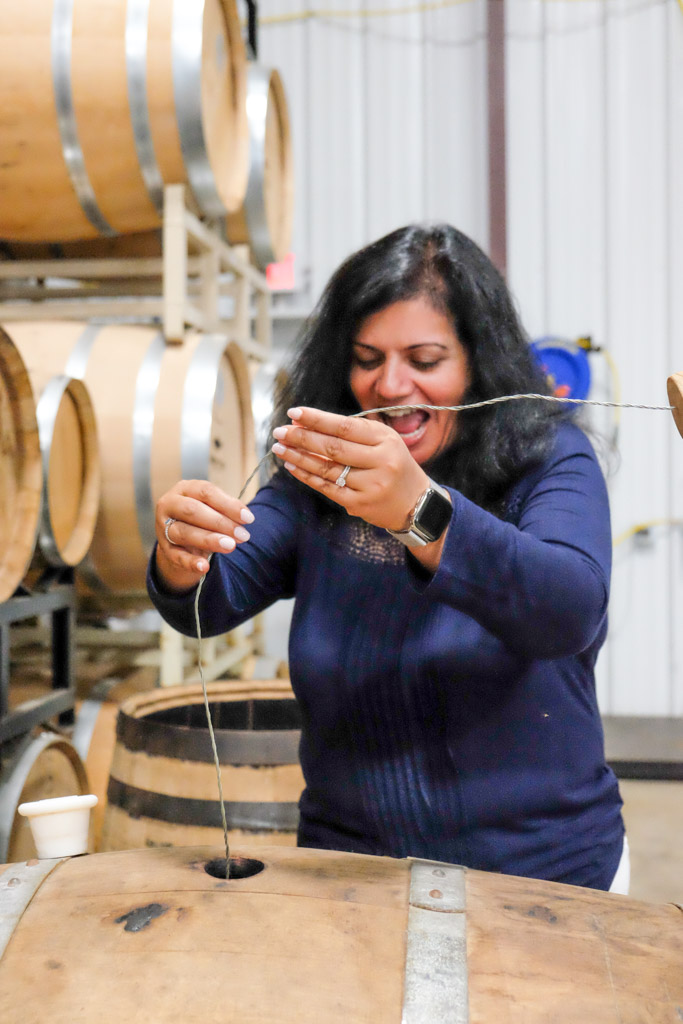
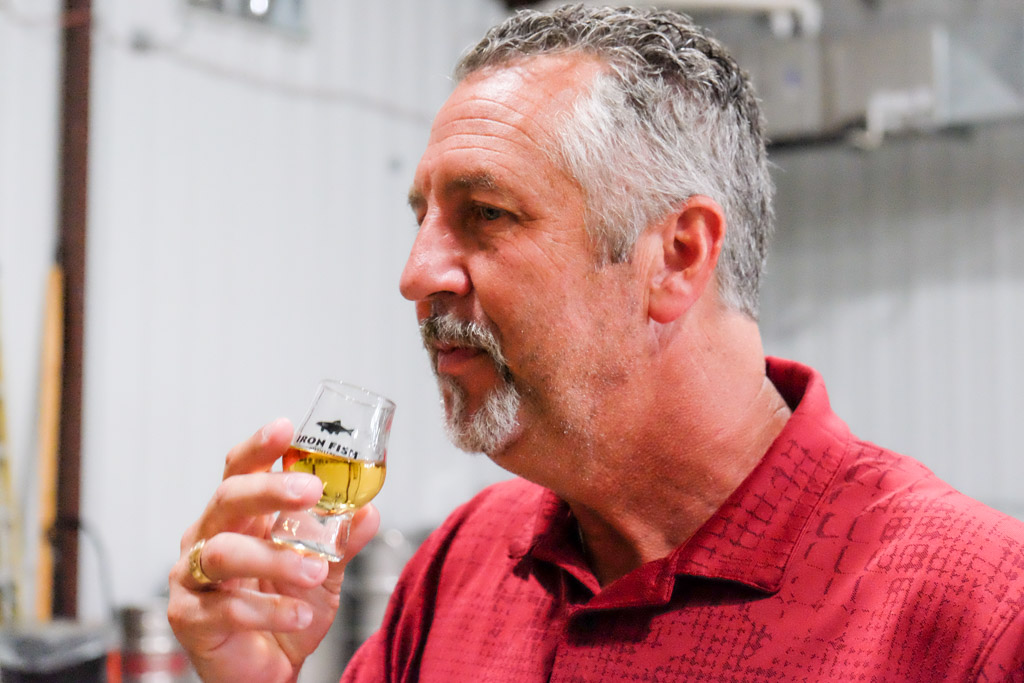
Dave wanted to try their Bourbon finished in a Mezcal barrel, so David went in search of that bottle, as it wasn’t out on the tasting area. While he went in search he left us to try their pre made Old Fashion finished in a maple syrup barrel. Now that was the best premade Old Fashion that we have all had, and we all purchased a bottle at the gift shop on the way out.
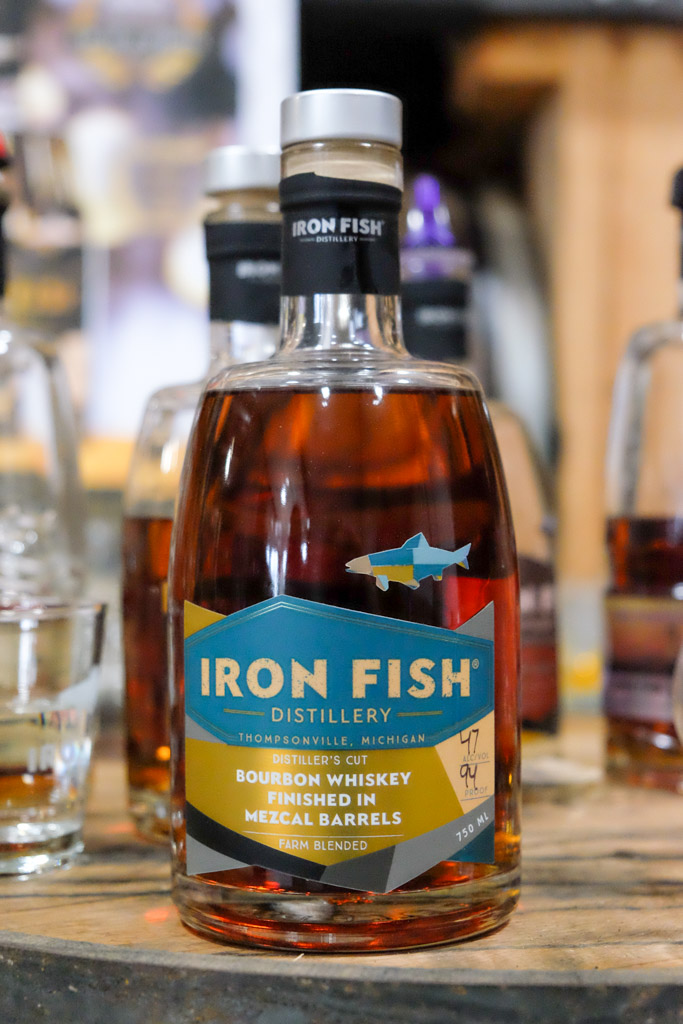
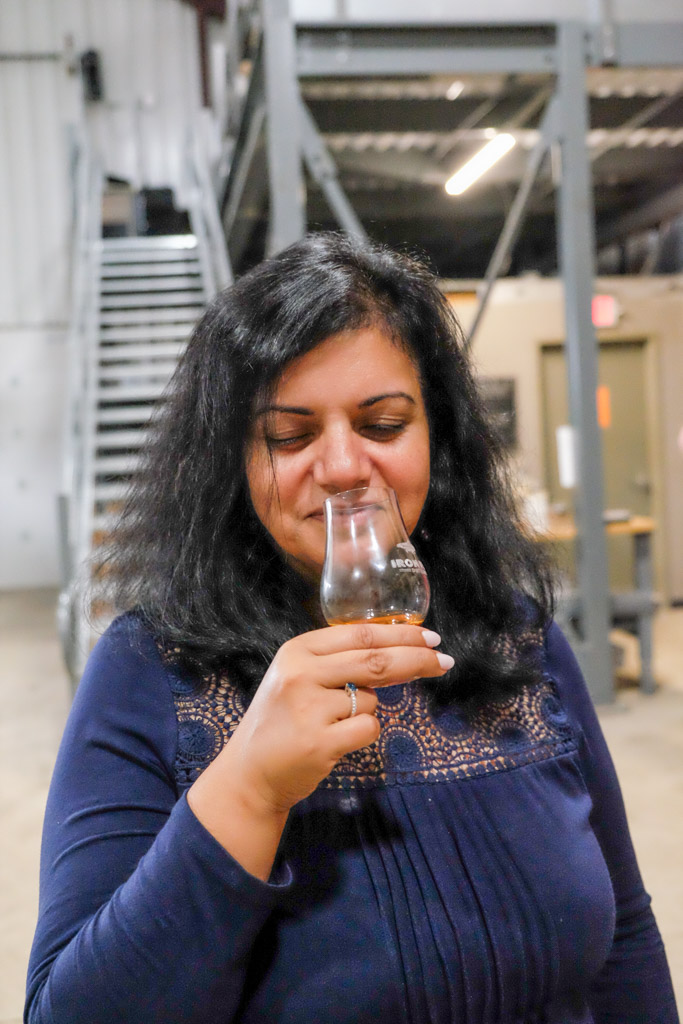
They use their high Rye bourbon for their Mezcal finish. David really liked it, I was worried as I don’t like Mezcal especially if it is peated, however this finish was anything but peated. We actually got a little root beer note on the palate. Dawn didn’t get any peatedness either and both her and Dawn like it a great deal. It was a toss up which one Dave liked best between the Four Cask and the Mezcal.
From the tasting room David lead us back to the bar and we all said our goodbyes and we all sincerely wished him the best of luck in the prosperity of the distillery. We assured him that we would be back, and that we would bring new people for him to make supporters of. It was a very good tour for us and we could not thank the entire crew enough for making our time at the Iron Fish Distillery as fun and educational as they all made it for us.
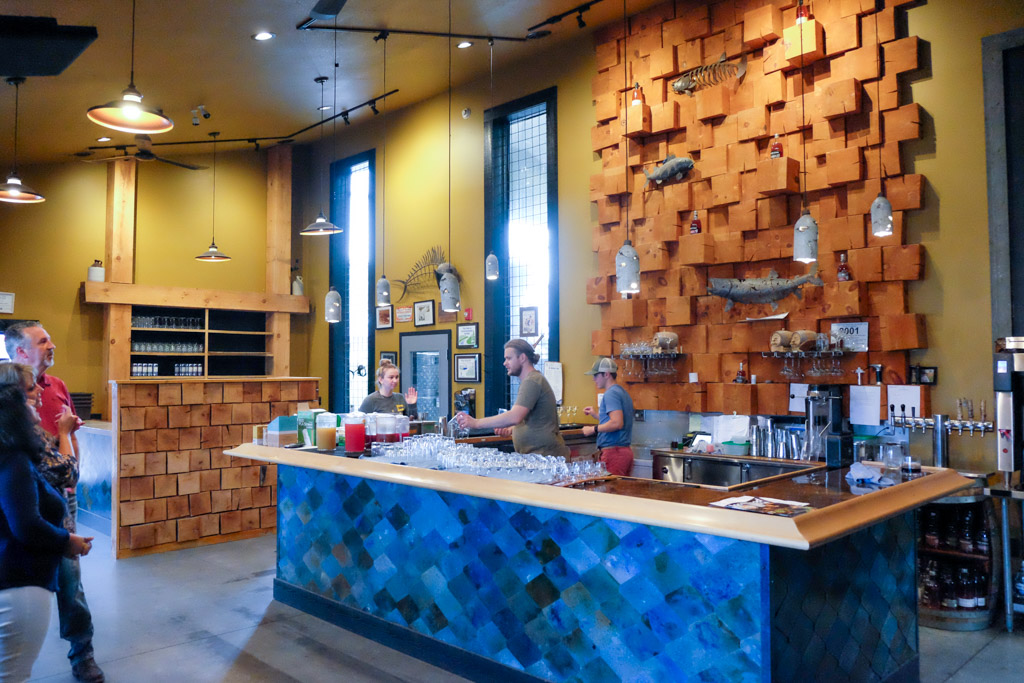
After saying our goodbyes, we went to the grain silo turned gift shop and purchased some of our favorite spirits that we tasted, and even some that we didn’t taste, along with a shirt or two. We loaded up the car with all of our purchases then went and found our restaurant host–Keith–to be seated for dinner.
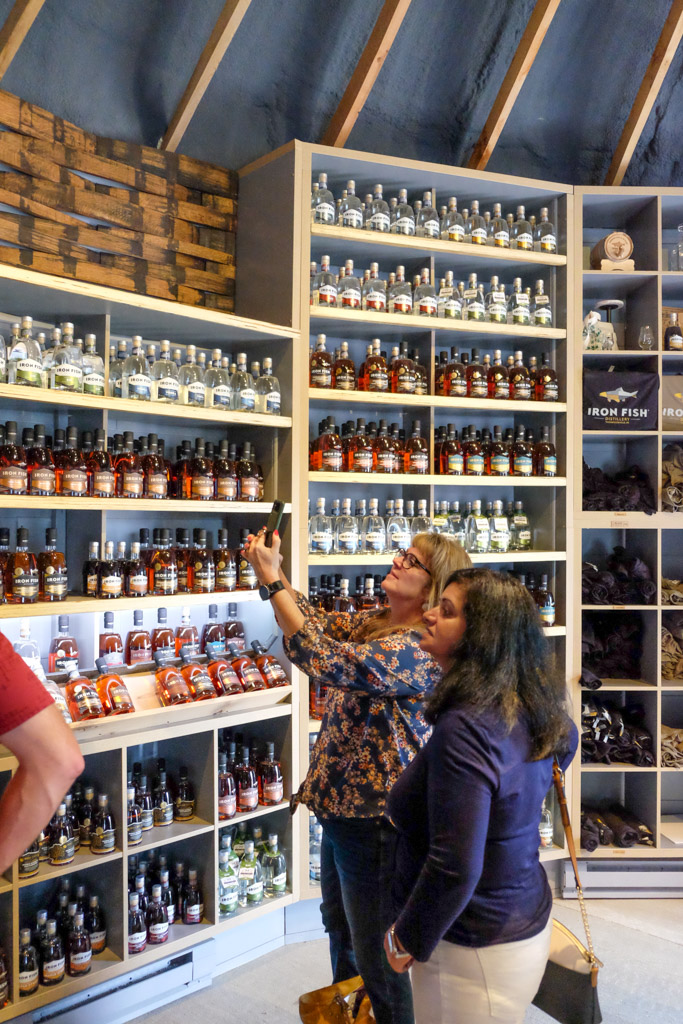
We were seated for dinner in the bar area, although we did have our choice of dining outside on the patio, but opted for the air conditioning as it was a little humid after the rain. While we were deciding on what to eat, Sarah–Heidi’s sister and Richard’s wife–came to the table and greeted us then told us of the story of how their WILE E COYOTE drink was first made. When you go their you will have to ask her to tell you.
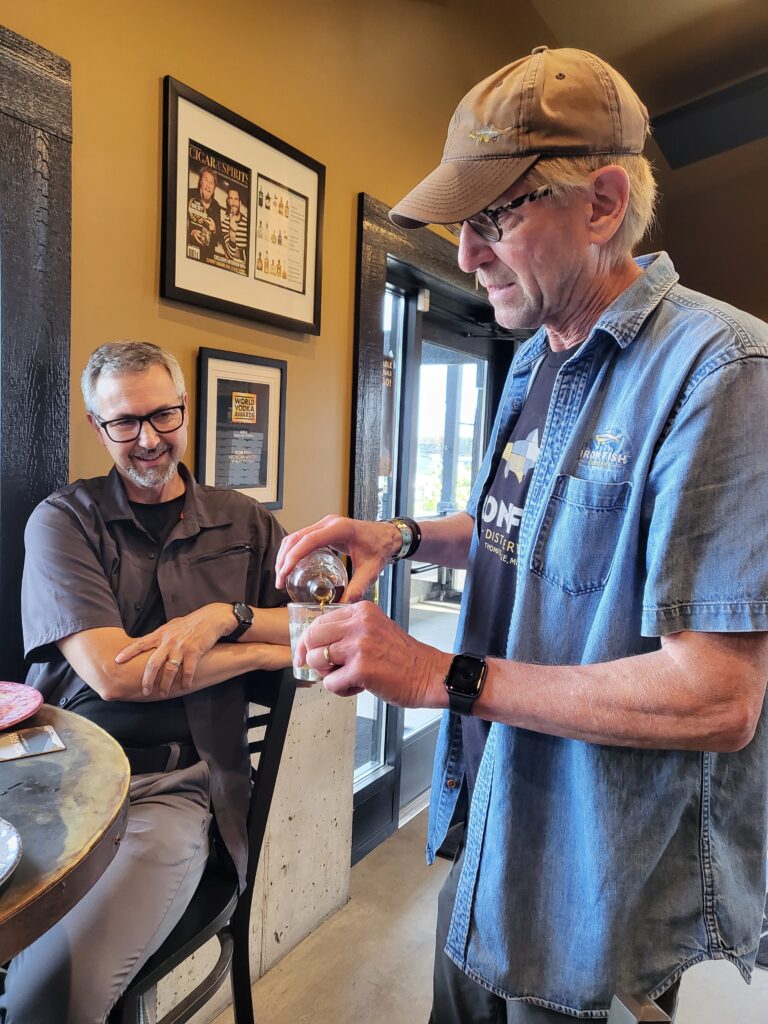
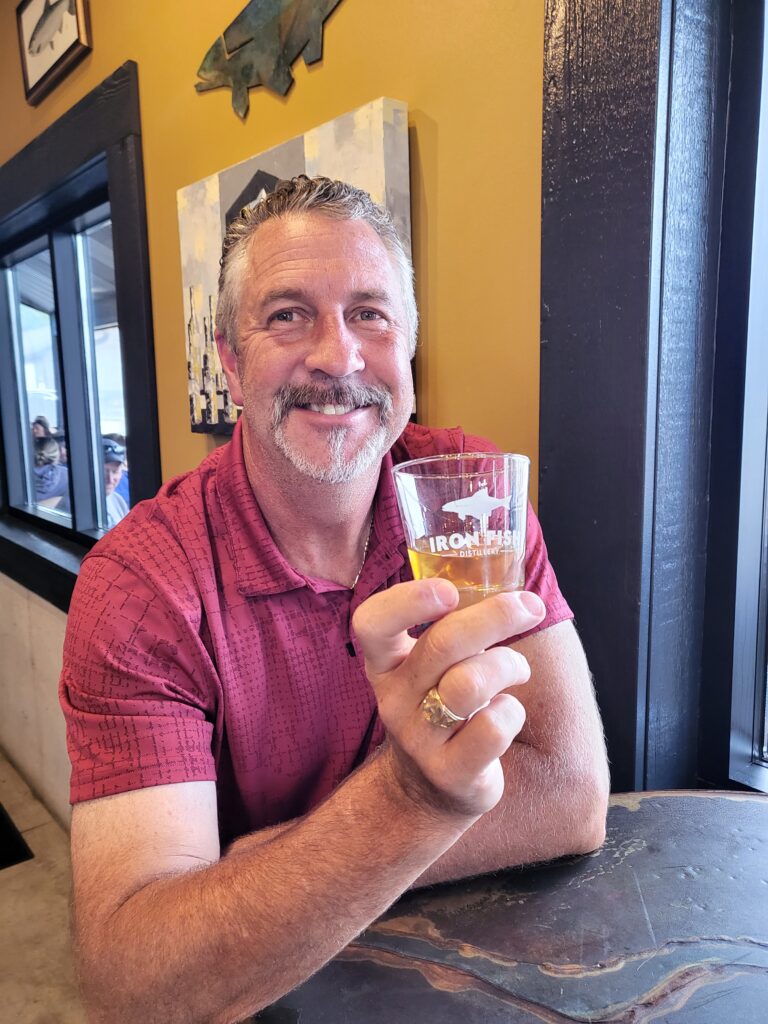
At dinner we ordered their hand made pizza and another cocktail or two, and preceded to have a very good meal. We must thank the staff at Iron Fish for making our stay there a very pleasant one. From Keith who met us at the door and made sure we were where we were supposed to be, to our bar tenders Logan and Forrest and finally to our waitresses Alexis, Casper and Marisa you were all wonderful to us and so much fun to be around.
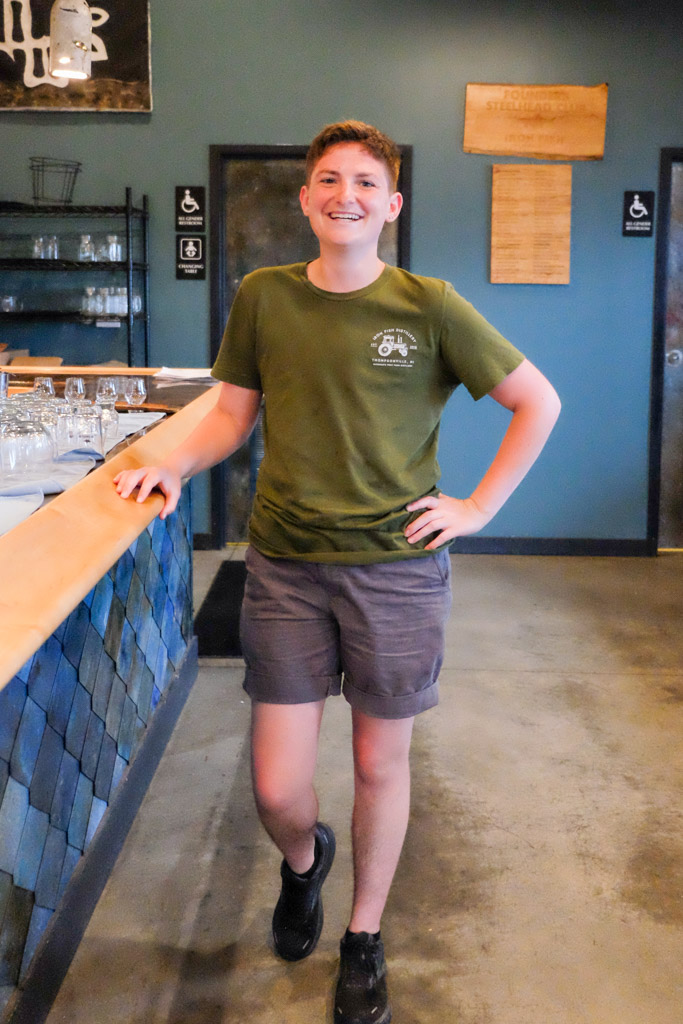
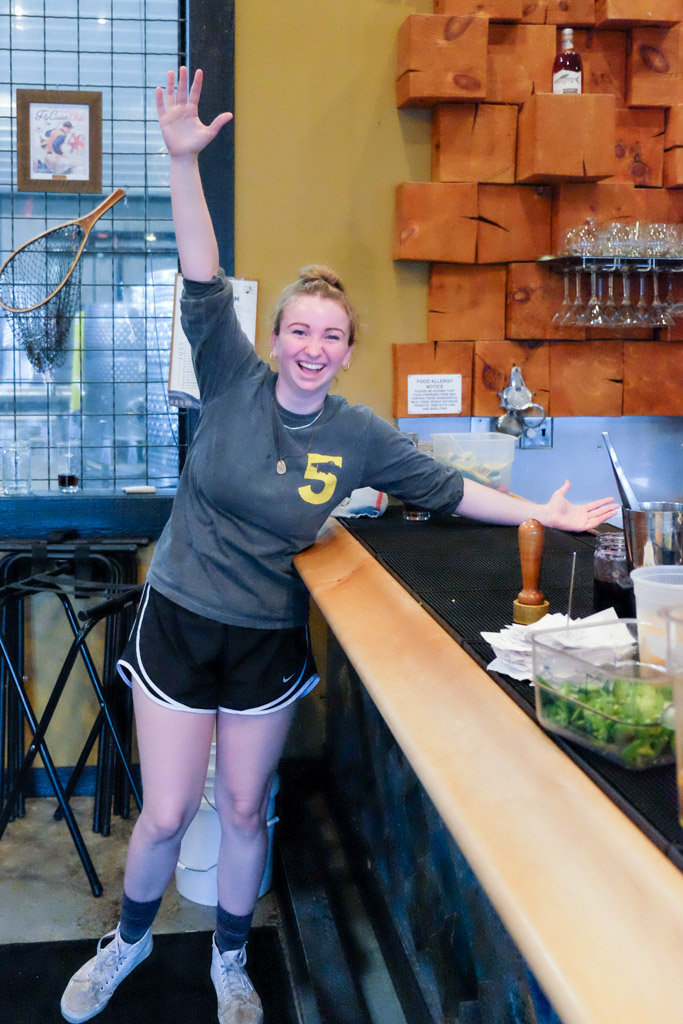
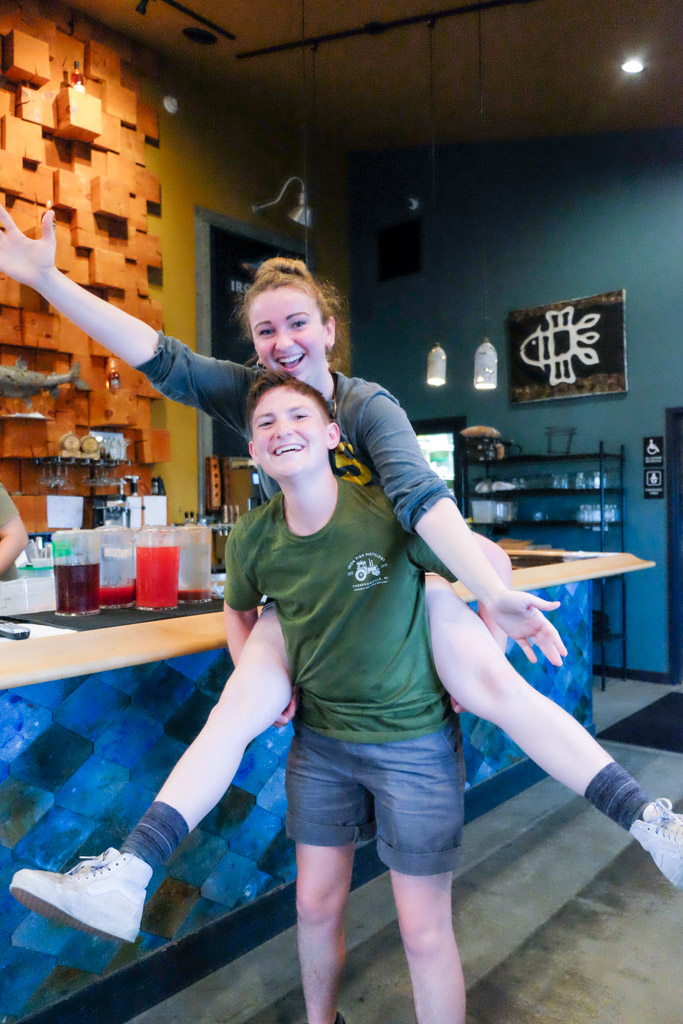
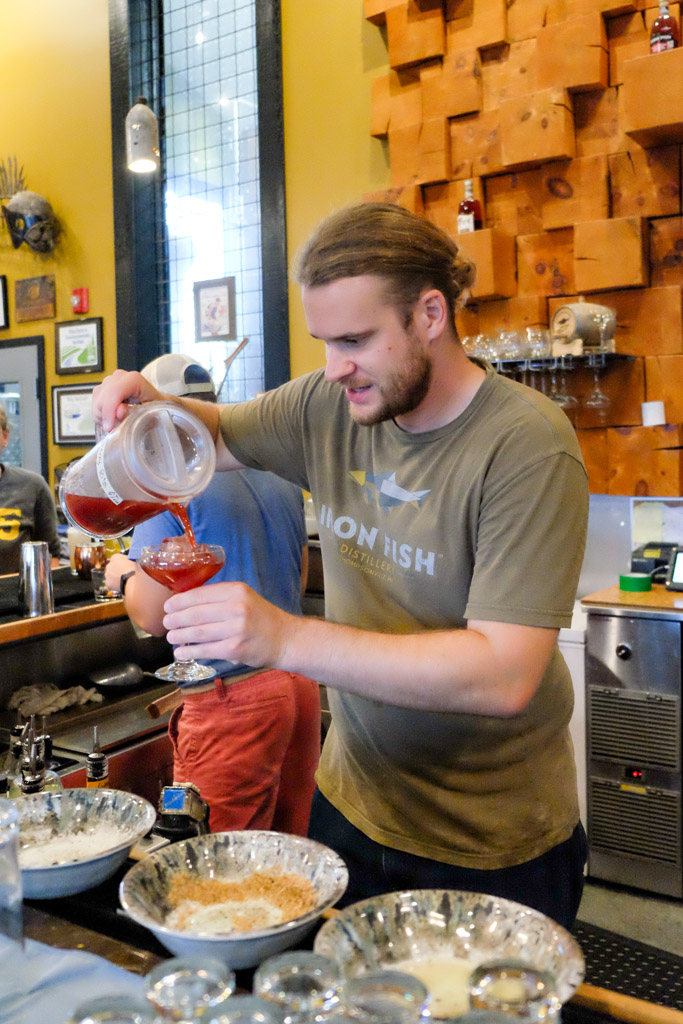
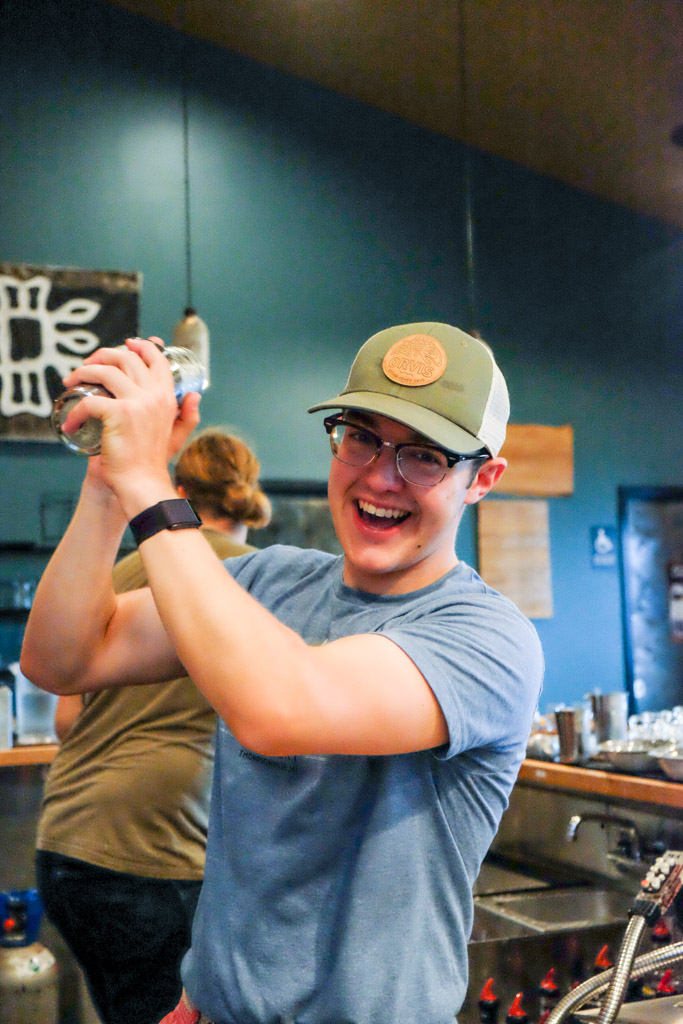
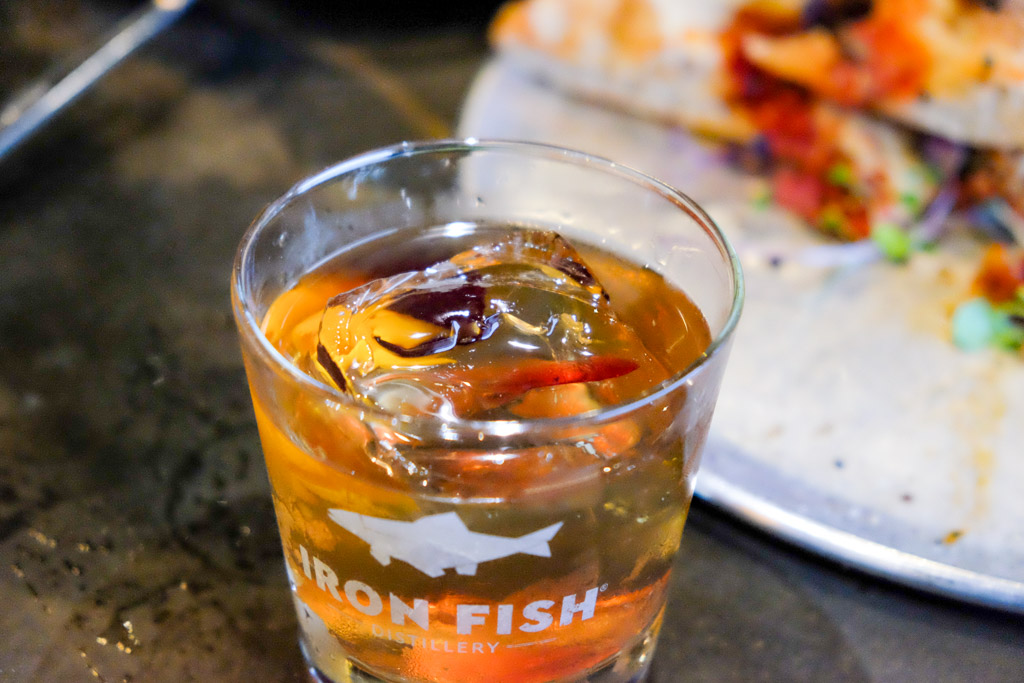
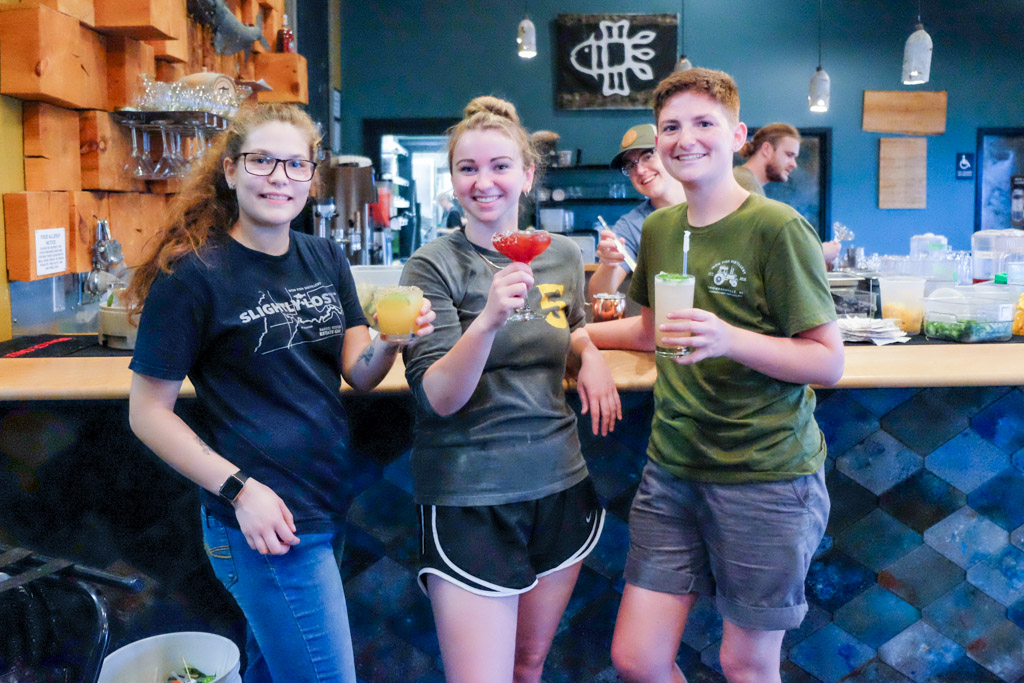
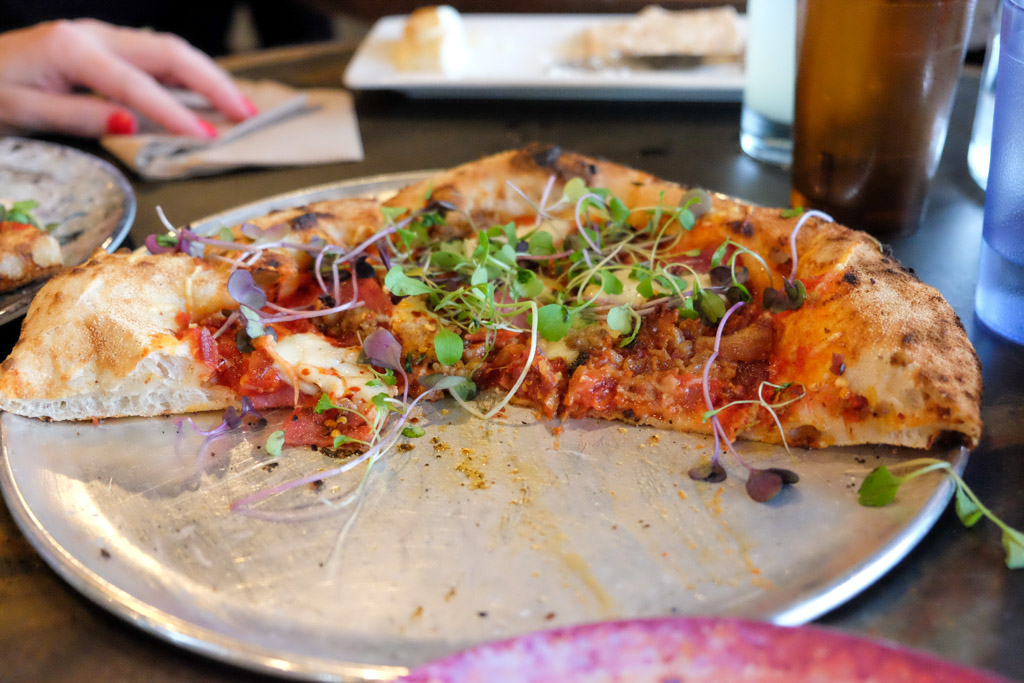
After dinner Richard came over and talk with us. He is a jovial individual and we enjoyed our conversation with him. We talked a lot about distribution and how they get their product on the shelves of liquor stores. We have not seen them much in Indiana, but we have in Michigan. We will try our best to help remedy that.
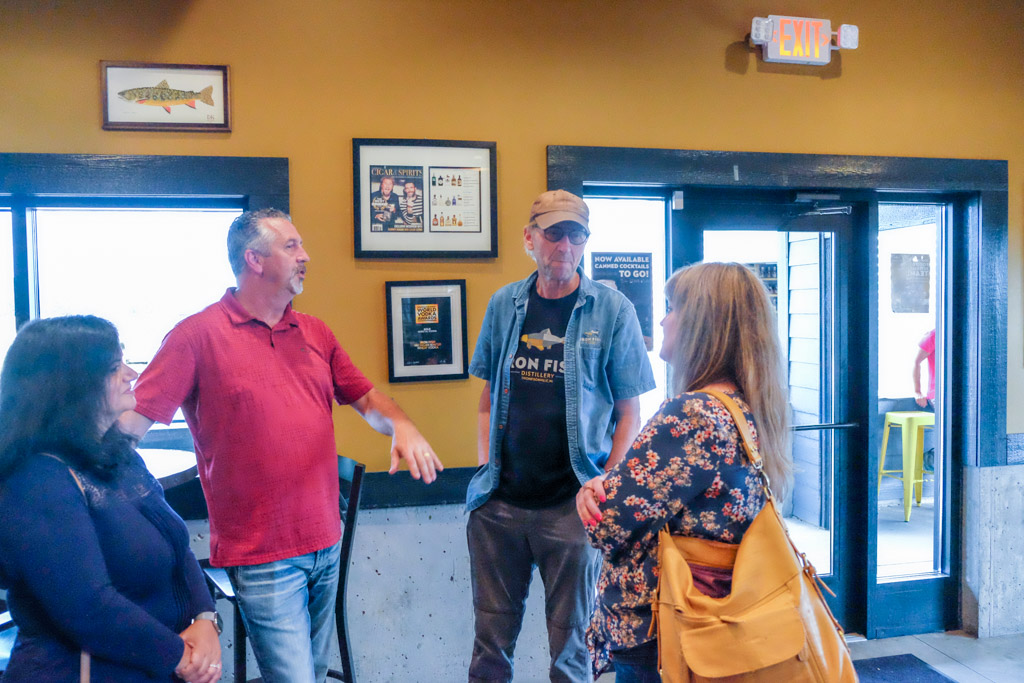
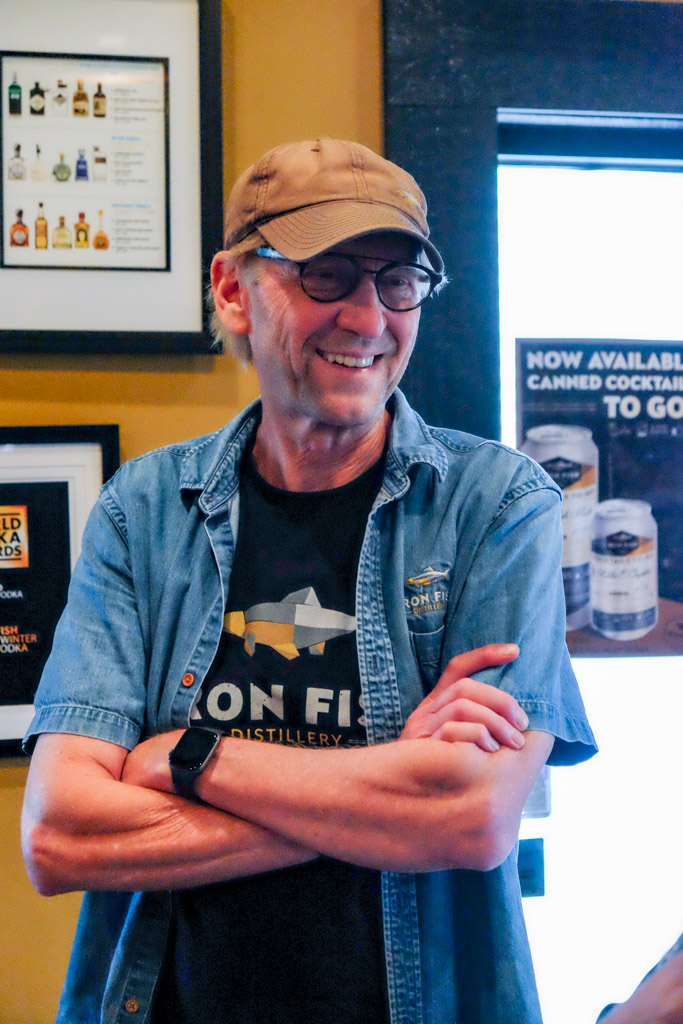
We want to give many thanks to our very gracious hosts David and Heidi along with Sarah and Richard for allowing us to come into their distillery and for letting us tour, taste, photograph and video our adventure with them. I and Dawn along with Dave and Nina want thank you all so much and we will certainly be back soon.
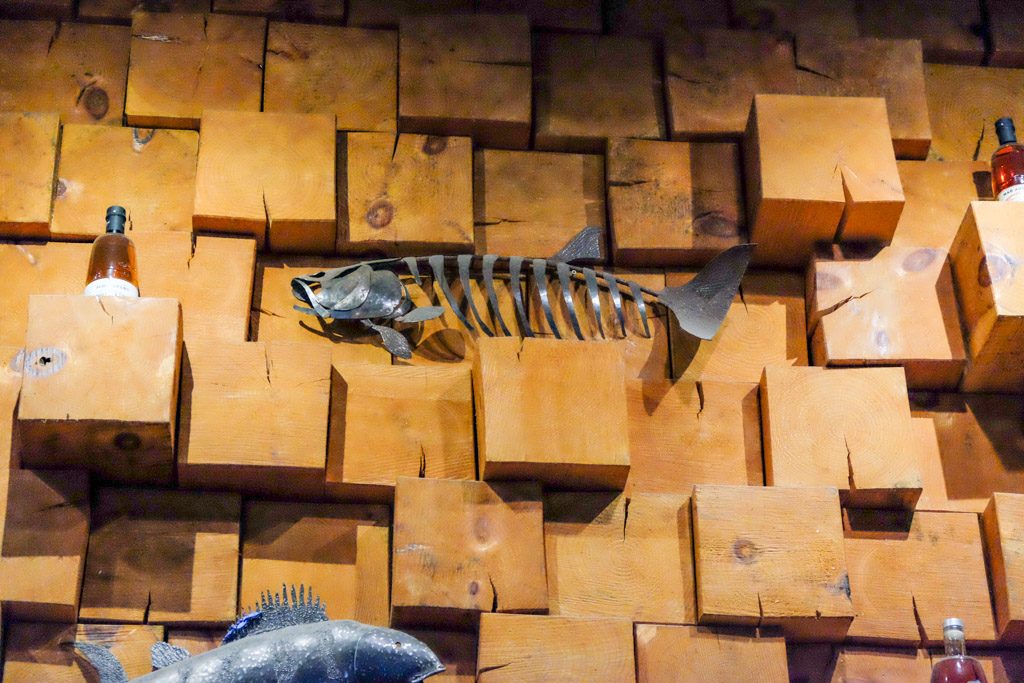
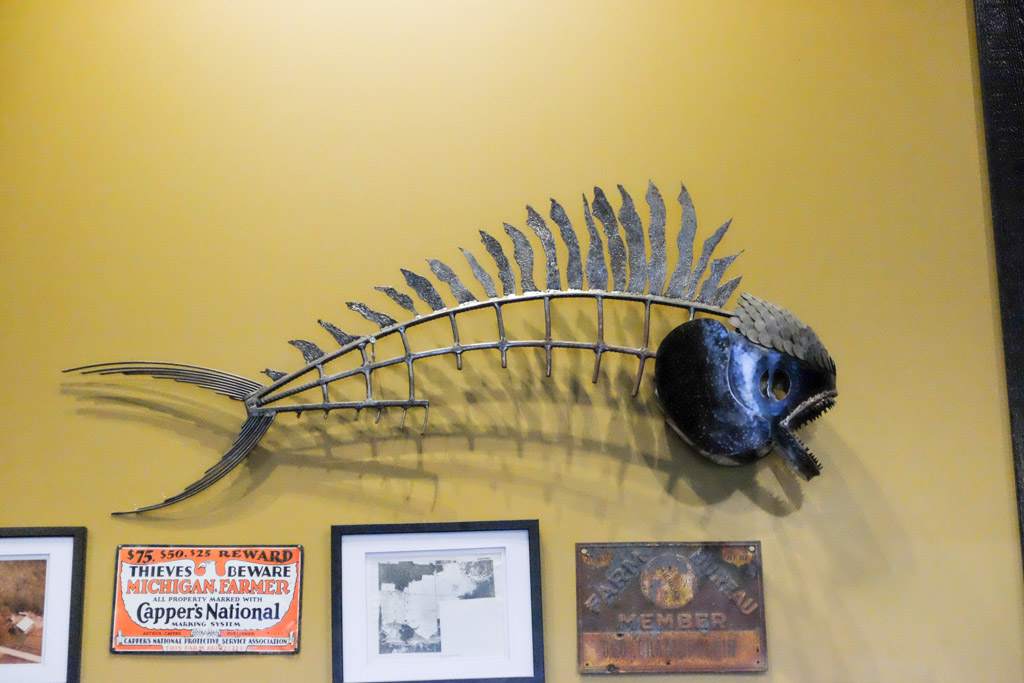
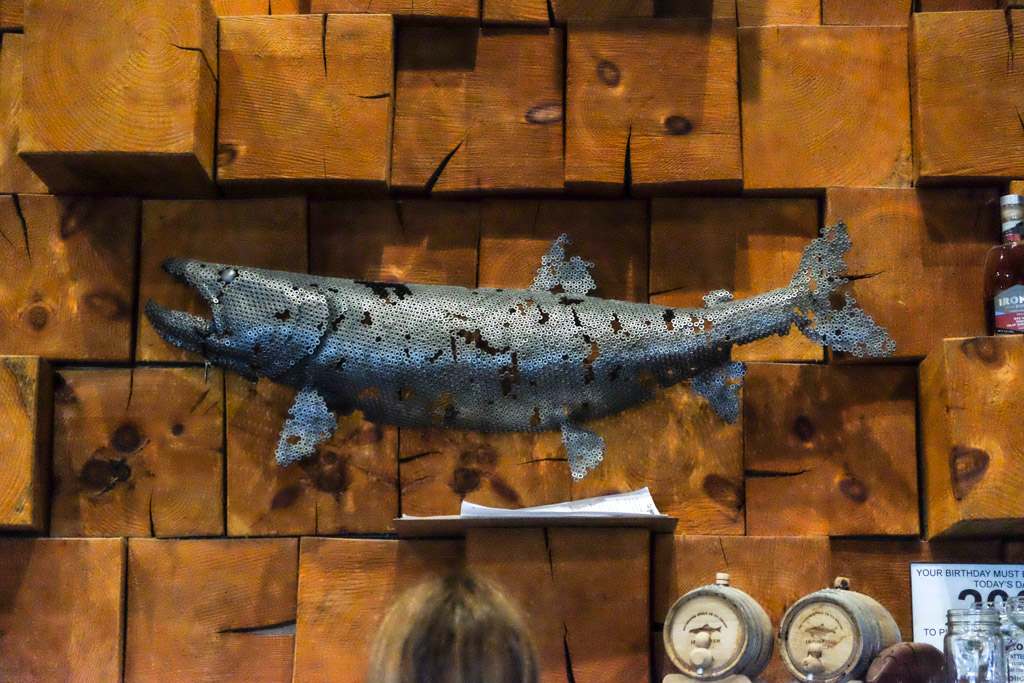
Links to Iron Fish Distillery:
Website: www.ironfishdistillery.com
Facebook: www.facebook.com/ironfishdistillery
YouTube: www.youtube.com/channel/UC5x3T2BdxFZJQZq0AO0LMNA
Twitter: www.twitter.com/IronFishDistil
Instagram: www.instagram.com/ironfishdistillery
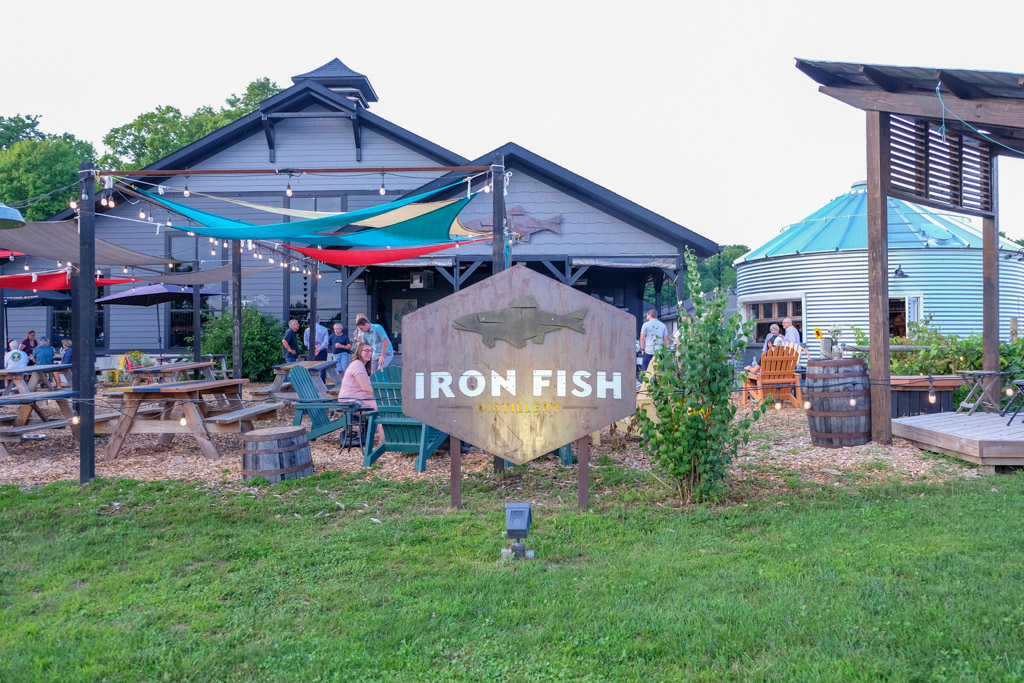
To see what we came back with and our photography of them in our studio,
see this post on the bottle photography.
1Brix of Maple Sap and Syrup
It takes above 40 volumes of maple sap to produce 1 volume of maple syrup. In other words, you will need to boil down 40 gallons of sap just to make one gallon of syrup. Maple sap only contains between 1.5-3.5% sugar and finished maple syrup contains about 66% sugar. Sugarhouses therefore have to evaporate the water in the sap to concentrate the sugars to form the syrup you put on your pancakes.
In the US and Canada, the dissolved solids content of maple syrup must be between 66% and 69%, using the Brix scale. The Brix scale is based on degrees, where 1 degree Brix is equal to 1% sugar. Since all of the dissolved solids in maple sap and syrup is from sugars, Brix is a convenient way to measure sugar content.
